In the software development world, MVP stands for minimum viable product and, in fact, is one of the most crucial steps when it comes to developing any product. From cost minimization to risk mitigation, MVP has numerous benefits to offer.
In this article, we will be looking at all possible aspects of this approach. As such, we will review what is MVP in software development, list steps on how to create a minimum viable product, overview the design and cost, compare it to other approaches, and much more.
It is evident that MVP software development is a vast field encompassing many aspects. Although the article may grow big as we overview all possible aspects, we divided it into essential parts. Hence, each part leads to a more detailed page outlining everything you need to know in more detail.
What is a minimum viable product?
Instead of just listing how to create an MVP, let’s start from the beginning and define the term we all gathered here for. A minimum viable product, MVP in short, is a foundational concept in product development. It represents the most basic version of a product that allows a team to test its fundamental hypotheses using the least amount of effort.
For example, if a company is looking to develop a marketplace complex in both design and development, MVP implementation may come in handy. In this case, the minimum viable product would be an extremely simplified version of the future marketplace. It will include only primary functionality and have fewer design intricacies. This way, the team can easily see if users like the product, as well as identify which functionality they may need to add in the future.
The main goal of an MVP is to swiftly introduce a functional product to the market, allowing teams to collect valuable user feedback. It prioritizes essential features and acts as a foundation for iterative enhancements, ensuring that subsequent iterations align with user needs and market demands.
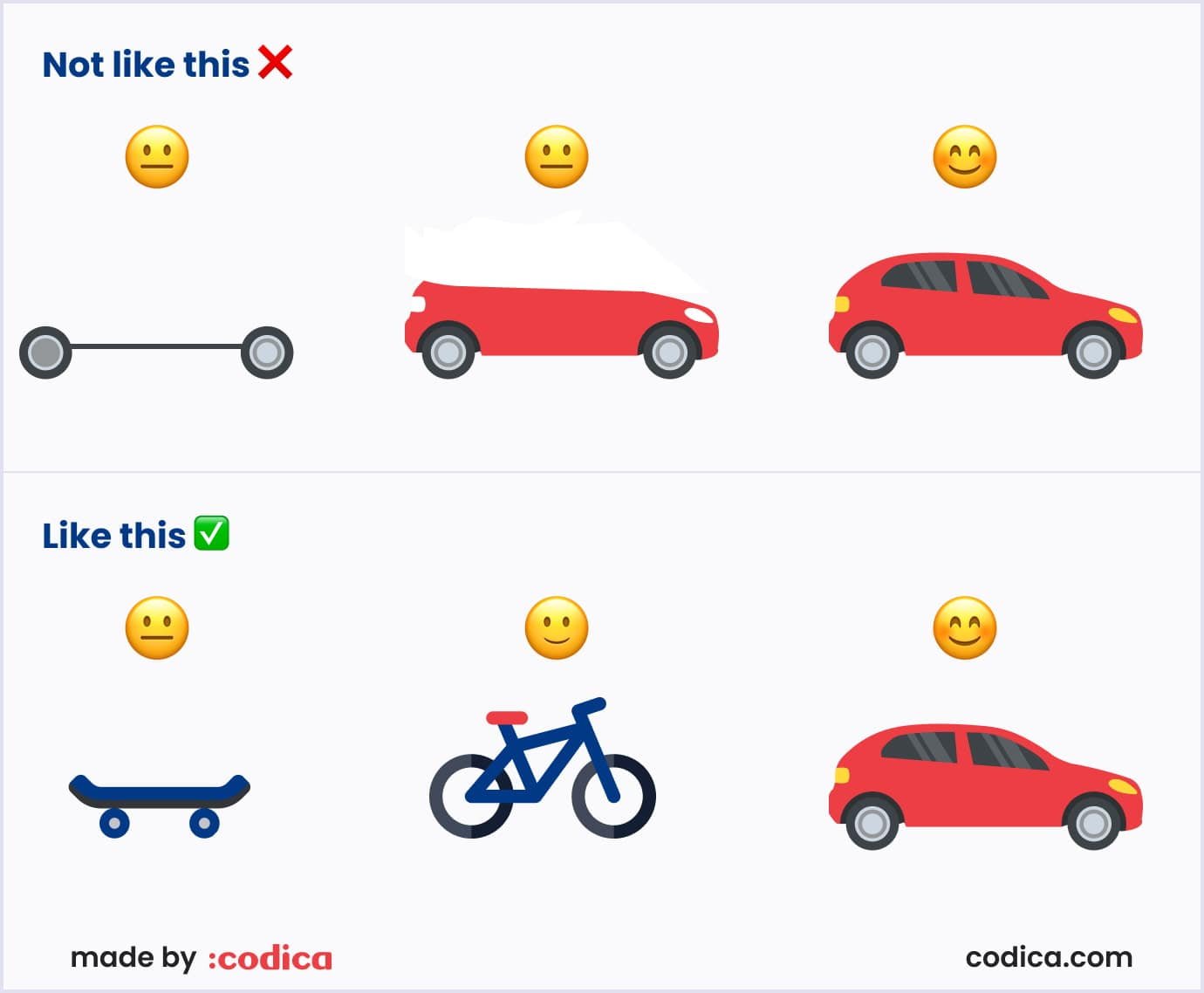
Basic goals in building MVP
Switching from the MVP definition, let’s overview what are the most basic minimum viable product goals you should pursue. When it comes to developing it, setting clear and strategic goals is crucial. The emphasis is always on simplicity and efficiency, aiming to achieve the following basic objectives:
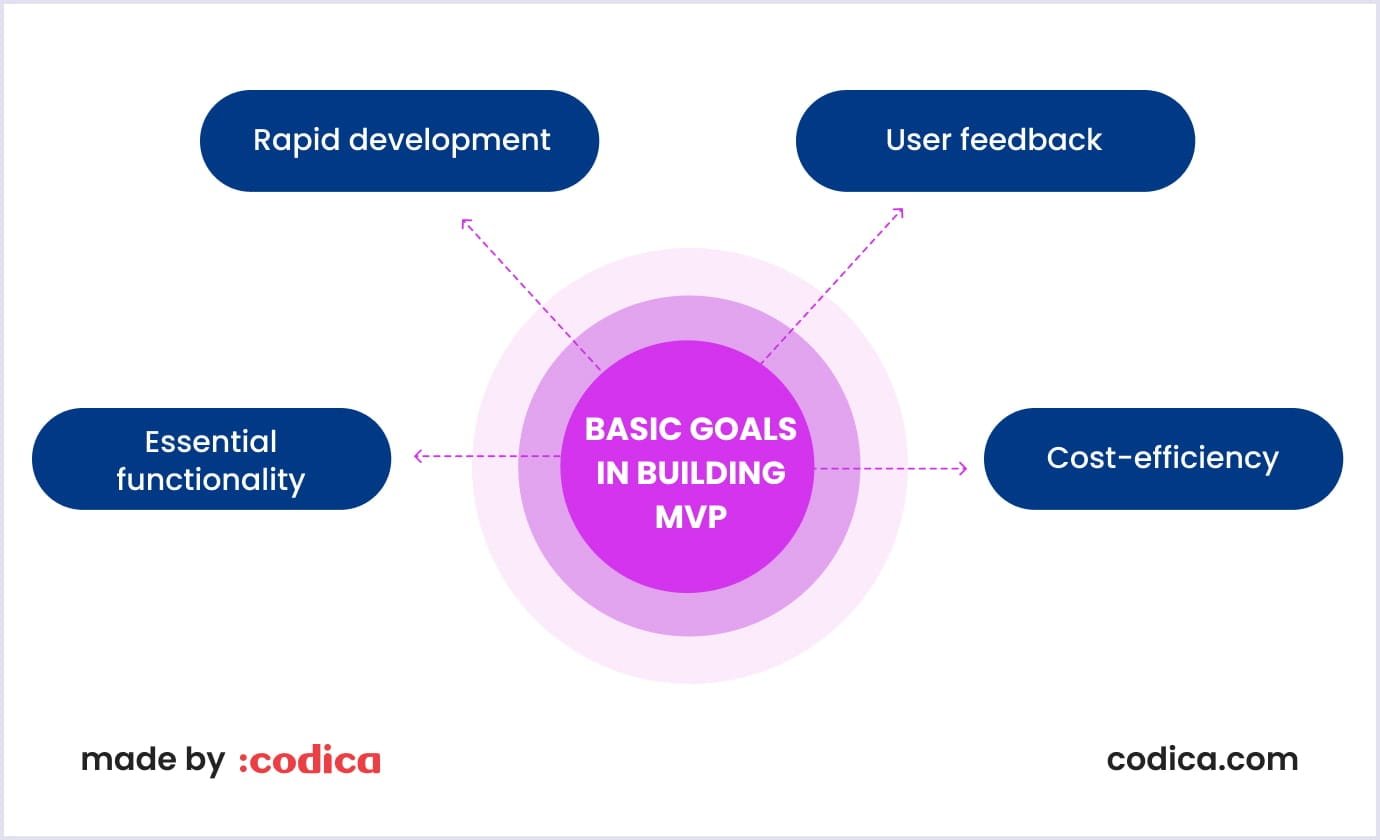
- Essential functionality. MVP includes only core features as they address the primary user needs or solve a specific, major problem.
- Rapid development. When developing an MVP, the speed is a priority. This way, you can swiftly bring the product to market and gather user feedback.
- User feedback. MVP aims to create a platform for early user interaction to gather insights that will guide future enhancements and iterations.
- Cost-efficiency. MVP minimizes development costs by focusing on essential features only, allowing you to optimize resources and cut down the development time.
By aligning efforts with these basic goals, a well-executed MVP lays the groundwork for a successful product, setting the stage for iterative development and continuous improvement.
MVP standards
Establishing MVP development standards is essential for maintaining consistency and clarity throughout the development process. These standards encompass various aspects, including:
- Usability. Ensure the MVP is user-friendly and emphasizes a seamless and intuitive experience despite its minimalistic nature.
- Feature selection. Clearly define criteria for selecting features that align with the core purpose of the product and provide immediate value to users.
- Scalability. Lay the groundwork for future scalability, allowing the product to evolve and expand as user needs and market conditions change.
- Feedback loops. Implement robust mechanisms for collecting, analyzing, and incorporating user feedback into subsequent development phases.
Speaking of the latter, at Codica, we practice feedback loops in our MVP product development services. They allow us to constantly monitor our products’ performance, as well as find out better ways to scale the product.
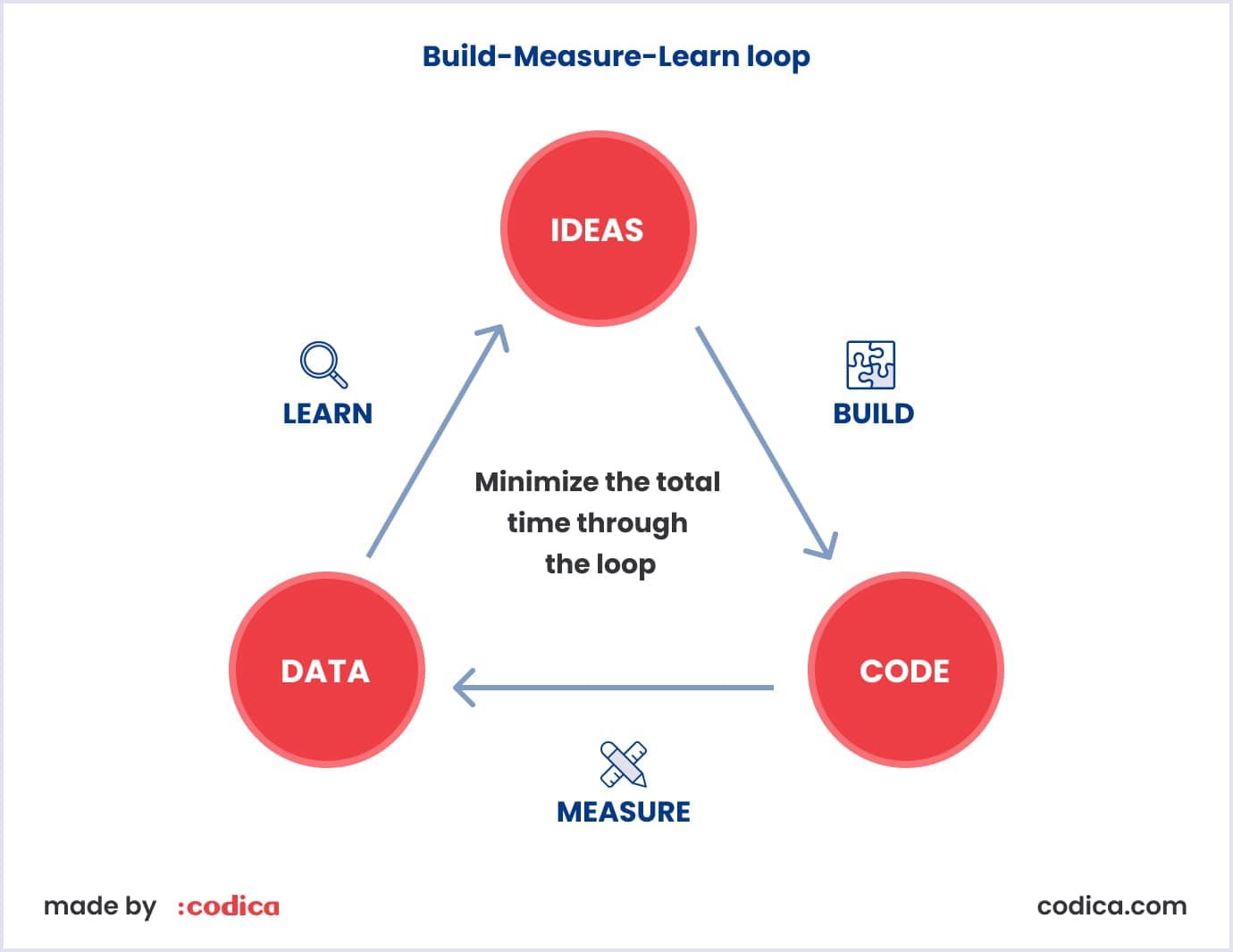
Summing up the chapter, adhering to the basic goals and standards is crucial. When all aspects and plans are in place and are well-defined, development teams can streamline the creation of an MVP. Consequently, the MVP approach increases the likelihood of a successful product launch and fosters a solid foundation for ongoing improvements.
Why startups need MVP software development
There’s a more efficient way to initially understand whether your idea will be required in the market. And this implies developing a minimum viable product (MVP). This popular approach in startup product development will help you test your business idea and save both time and resources. This way, you understand what users need and can create an offering that they are ready to pay for.
When it comes to developing a minimum viable product, it brings invaluable benefits to the venture. But why? In their essence, startups, although bring innovation and novelty, are very risky. They often lack investment, reliable team, and resources.
Thus, MVP can greatly eliminate major startup problems. This approach will allow startups to make effective and thoughtful decisions. To do so, let’s list the ultimate advantages of startup MVP development.
Accelerated time to market
With MVP startup in place, you can bring the product to market swiftly. By focusing on essential features, the development cycle is significantly shortened. This rapid deployment helps startups stay ahead of the competition and gain early market traction.
Meet the needs of your core audience
MVP startup software development enables startups to identify and address the specific needs of their core audience. Startups can collect valuable feedback from early adopters by launching a simplified version of their product. This process ensures that subsequent iterations are better aligned with customer expectations and preferences.
Minimize risk
Launching a full-scale product without testing its viability can be risky for startups. MVP development mitigates this risk by enabling entrepreneurs to validate their product concept with minimal investment. This iterative approach ensures that resources are allocated efficiently, reducing the financial and operational risks for MVP startup associated with developing a fully-featured product from the outset.
Capitalize on quick wins
By focusing on the essentials in the MVP, startups can deliver quick wins to their customers. These early successes not only boost morale within the development team but also create positive momentum in the market. Quick wins can lead to increased user adoption, positive word-of-mouth, and a stronger foundation for future product enhancements.
Focus on the essentials
MVP development for startups forces the latter to prioritize and concentrate on the core functionalities that are essential for the product's success. This focused approach helps in avoiding unnecessary features that might complicate the initial release. By honing in on what truly matters to users, startups can deliver a lean and effective product that resonates with their target audience.
Although this list is just a sneak peek, it clearly outlines why startups need MVP. However, there are far more reasons than listed above. Hence, in another article of ours, we take a closer look at MVP startup software development, focusing on the potential benefits it can bring to the table.

Steps of MVP development process
With all the theory buckled up, let’s move on to the MVP development process. In a nutshell, it isn’t complicated, yet dividing it into sizeable milestones is a must. So, when it comes to MVP in software development, there are several crucial steps.
Define the problem
Clearly, MVP gets created to solve a particular problem, be it an instability of the idea, lack of potential users, or others. So, to make the most of your MVP goals, clearly articulate the problem it aims to address.
In this regard, you would need to understand the pain points of your target audience and identify the specific challenges your product intends to solve. A well-defined problem sets the stage for an effective solution.
Do market research
Your future MVP is highly dependent on the market it enters. Before diving into MVP software development services, proper market research is a must.
In market research, there are various aspects you have to understand. For instance, understand your target audience with their problems and desires, and research competitors. Additionally, each market follows trends and it’s crucial to have a keen eye on them, as they provide both opportunities and challenges. This knowledge will guide your MVP strategy.
Get a clear idea
Following problem definition and thorough market research, you should have a well-defined business idea for your future MVP. Specify the problem it addresses, articulate the value it offers users, and clarify goals, objectives, and a unique selling proposition. This clear vision ensures a focused and purposeful development process.
Find a reliable IT vendor
Finding a solid IT vendor is another crucial yet often forgotten step. Selecting a trustworthy IT vendor is crucial for successful custom MVP software development.
In this regard, you ought to take into consideration various aspects. For instance, consider factors like the vendor’s experience in your industry, a proven track record, and the technical expertise to bring your vision to life. Besides, consider the location, as differences in time zones may complicate the development process. Additionally, note that pricing also changes based on the location.
Go through the product discovery phase
Before development kicks off, going through a product discovery phase is a must. At Codica, product discovery is a service we offer. Essentially, it encompasses numerous aspects of future product development, some of which are mentioned in this section.
Basically, at this phase, we perform complex research and analysis of the client’s idea to develop a solution that meets all their needs. Throughout the discovery session, our team reveals all the MVP advantages and weak points at the earliest stage possible.
Accordingly, this approach allows us to set up a risk-free environment for development, increase efficiency, as well as minimize development expenses. To put you in context, the product discovery services we offer are often divided into 6 essential milestones, where we:
- Evaluate the initial concept;
- Set criteria for success;
- Specify the features required;
- Develop a proof of concept;
- Construct prototype models;
- Verify the project’s validity.
Each of these steps creates a solid foundation for a future product. Additionally, feel free to take a look at the video explaining everything about product discovery.
Define the main features and prioritize them
Although defining MVP’s main features is included in product discovery, this process deserves separate mention. Following the idea that a minimum viable product features only essential functionality, it requires careful planning.
Find out which features form the core of your MVP and prioritize them based on user needs, value proposition, and development complexity. This ensures a focused and efficient development process.
Iterate constantly
It is highly unlikely the product will stay unchanged after the initial release. Hence, an iterative approach is the right way to go, as it creates space to regularly update the MVP.
Consistently collect feedback from users and stakeholders, incorporating it for ongoing improvements. Iterative refinement ensures your MVP stays in line with changing market demands. This interactive approach aligns closely with the principles of Agile methodology, which we’ll delve into next.
Agile methodology for MVP development
As established earlier, the MVP concept centers on developing a minimal version of a product with essential features to meet the needs of early adopters. The main objective is to quickly introduce a functional product to the market and gather user feedback. How does this relate to the Agile methodology?
What is the Agile approach and what it has to do with MVP?
Certainly, Agile represents a project management and product development approach that places emphasis on flexibility, collaboration, and integrating customer feedback. It is considered the best approach compared to traditional, rigid project management methodologies, aiming to address the challenges associated with changing requirements, unpredictability, and the need for rapid adaptation in software development.
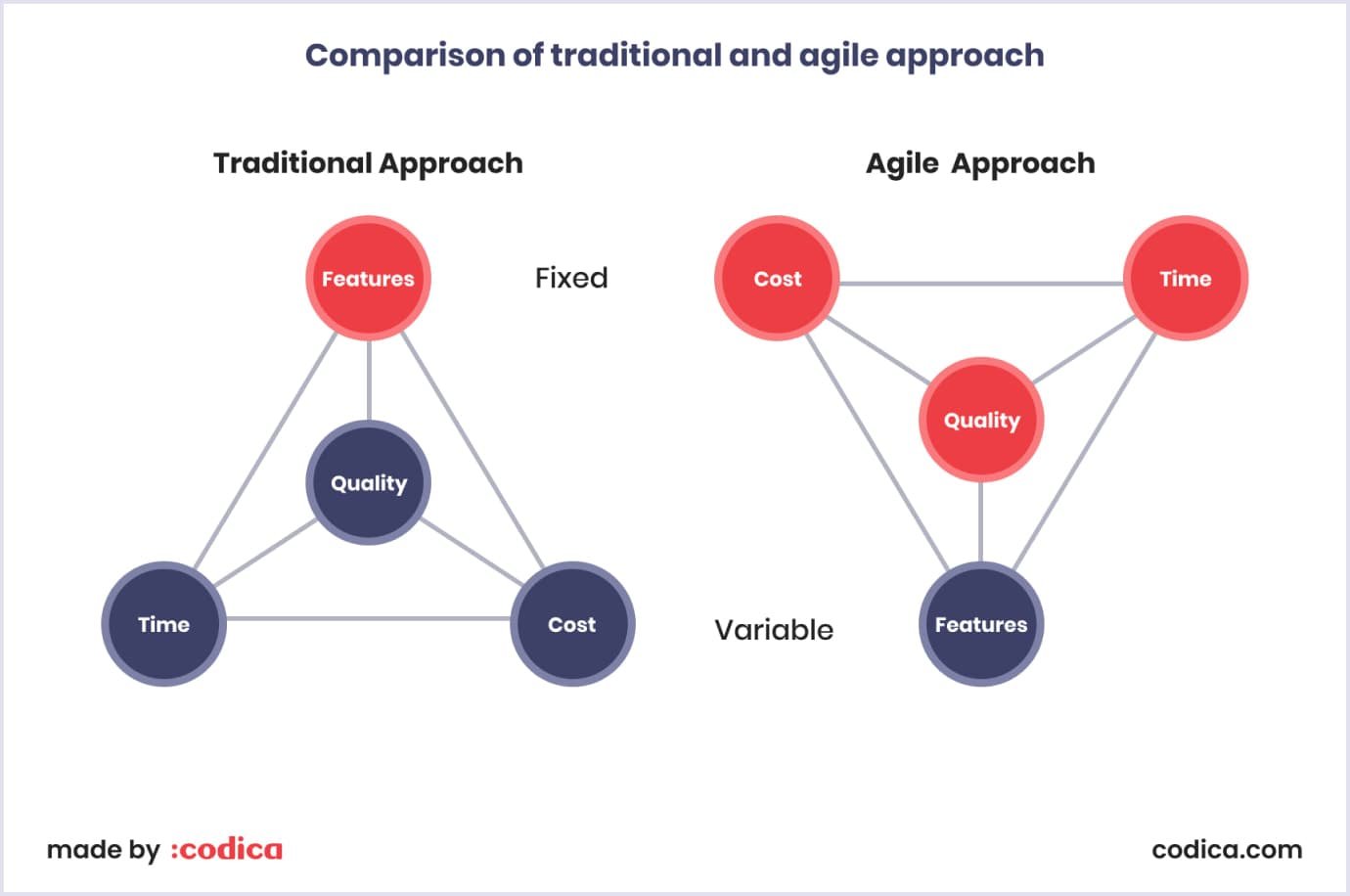
Agile methodologies, exemplified by Scrum and Kanban, divide projects into smaller, manageable iterations or sprints. This facilitates teams in delivering incremental value and responding to changes more effectively.
As you can see, the connection between Agile and MVP is quite evident. It lies in their shared principles and goals, such as iterative development, customer-centricity, flexibility, and risk management.
Benefits of starting with MVPs in the Agile approach
Traditional methodologies like Waterfall aim to deliver products in one batch, with little to no feedback incorporation. Needless to say, such an approach often fails in the market for various reasons. Thus, starting off with an MVP in the Agile approach is the winning decision, and here are several benefits it brings you.
- Early user feedback. MVPs enable teams to engage users early in the development process, collecting valuable feedback to refine and enhance the product.
- Faster time to market. By focusing on essential features, MVPs expedite the product release, allowing businesses to enter the market swiftly and gain a competitive edge.
- Risk mitigation. Developing an MVP helps identify potential challenges and risks at an early stage, allowing for timely adjustments and minimizing the impact on the overall project.
- Cost efficiency. Building only the core features initially reduces development costs, providing a cost-effective way to test the product’s viability before investing in additional features.
- Adaptability. The MVP Agile combination ensures that development teams can easily adapt to changing requirements, market dynamics, and customer preferences throughout the development lifecycle.
- Continuous improvement. The iterative nature of Agile and MVP encourages a culture of continuous improvement, fostering innovation and responsiveness to evolving market conditions.
MVP Agile encompasses dozens of aspects, and it would be challenging to describe everything without leaving the scope of the article. Hence, check out our deep dive into MVP in Agile development if you’re looking for a more detailed overview.
Minimum viable product vs prototype vs PoC
In software development, although MVP is a unique approach, there are others quite similar to it. When it comes to testing the product’s viability, MVP is not always the perfect tool for the job. In this regard, there is also a prototype and a proof of concept. So, let’s overview both and see how they compare to the MVP.
What is proof of concept?
A proof of concept (PoC) is a concise project designed to verify the feasibility of a particular idea. Companies commonly engage in PoCs for internal testing in the early stages of product development. In diverse industries, a proof of concept acts as a testing ground for exploring innovative concepts.
The primary goal of a PoC is to determine if a particular functionality can be successfully integrated into a real-world product. It also sheds light on potential challenges that may arise during the development process and user acceptance. The final design of a PoC need not be flawless; rather, its purpose is to showcase the viability of the concept before committing to full-scale development.
At Codica, we developed PoCs in many projects. Thanks to the experience we gained, we started defining and developing proof of concepts with 4 essential milestones in mind.
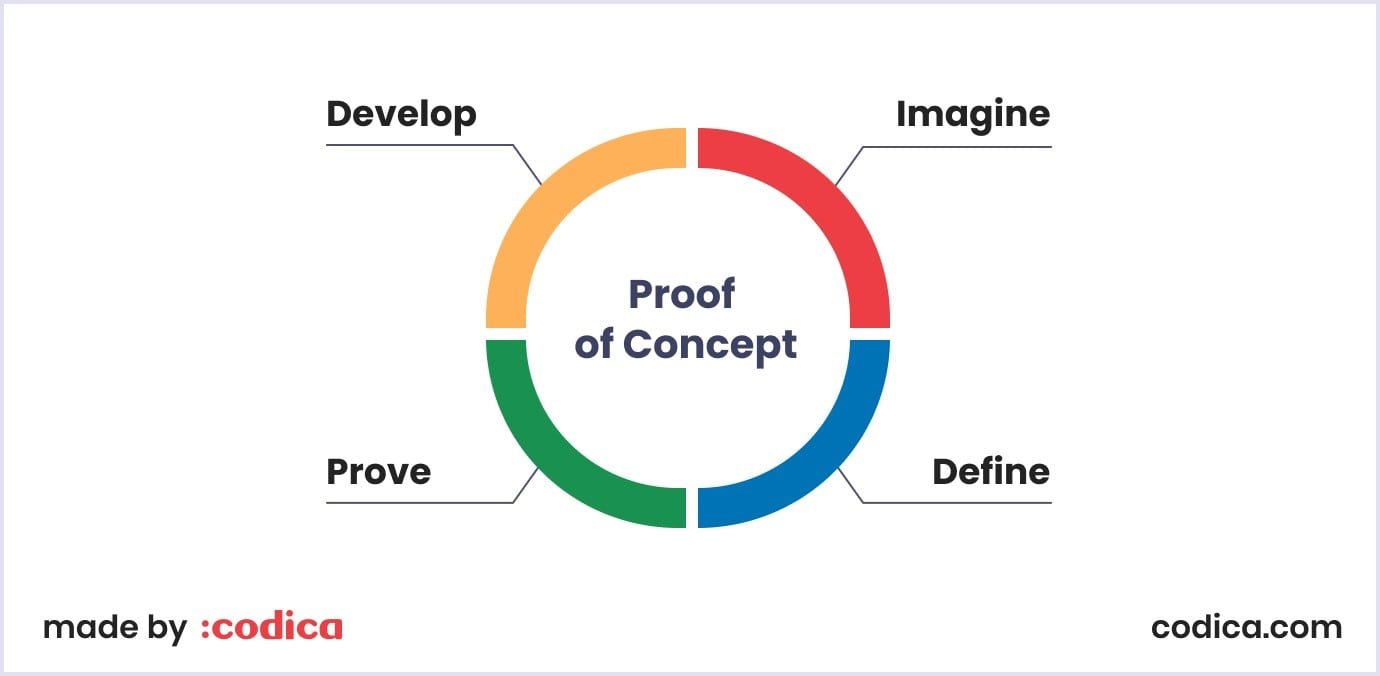
- Imagine. This step involves envisioning a concept or idea. This could stem from identifying a potential solution to a problem or exploring a new feature. During this phase, creative thinking and brainstorming lay the foundation for the PoC.
- Define. Define the key parameters and goals of the proof of concept. Clearly outline what needs to be proven and set specific criteria for success. This phase involves detailing the scope, functionalities, and limitations of the PoC to provide a clear roadmap.
- Prove. The core of the proof of concept process is to prove the feasibility of the imagined concept. This involves the actual development and testing of a small-scale version of the software. The focus is on demonstrating that the proposed solution or feature can be implemented successfully and meets the predefined criteria. The emphasis is on validation rather than perfection.
- Develop. The final step involves transitioning from the PoC to full-scale development. Lessons learned from the proof of concept, including insights into technologies, potential challenges, and user feedback, guide the development team in building the complete software solution. The PoC acts as a crucial precursor, streamlining the development process and minimizing risks associated with scaling the software.
What is a prototype?
In software development, a prototype is like a preview of the real product. It can be a simple sketch or a more interactive model that mimics actual software. Whether you want to simulate an entire mobile app or just a specific digital interaction, prototypes are versatile.
The minimum viable prototype has a main job which is to gather early feedback on design and functionality before diving into detailed coding. This way, you can make necessary improvements early on, saving time and effort in the later stages of development. So, prototypes are like trial versions that help refine your software idea before it becomes the real deal.
Unlike MVPs, prototypes are merely visual representations of the future product. They don’t include user interface (UI) design, focusing only on user experience (UX). However, they serve as a handy draft for the development team. With prototypes, teams have a reference when building an actual product, which helps them deliver exceptional quality software.
Speaking of examples, here’s a prototype our design team prepared. As mentioned earlier, it lacks UI design, yet it does a great job showing all UI elements placing, paddings, and other important details.

MVP vs PoC vs Prototype
After all the theory is outlined, let’s move to the direct comparison. This way, the table would be of great help as it shortly lists all differences between MVP, PoC, and prototype.
| MVP | PoC | Prototype | |
| Definition | A basic workable version of a product | Theoretical proof of idea viability | Visual presentation of the proven idea |
| Purpose | Present an early product version to users | Define the feasibility of the project | Define basic features, structure, and user workflow |
| Development time | 3 to 5 months | 2 days to 1 week | 1 to 4 weeks |
| Features | Core features, including UX/UI | Description of technologies to be used | UX design (excluding UI) |
| When to choose | When you need to launch early and get feedback from customers | When examining scalability, it is essential to evaluate risks, determine the timeframe, establish a budget, and project potential revenue | When you need a draft for further development |
| Testing approach | With target users | Internally | Internally and with a small target group |
As you can see, PoC vs prototype vs MVP purposes differ, and they should never be used interchangeably. However, when planning a new product, make sure you find a place for one of the three approaches we covered. Each of them greatly simplifies the development process fostering data-driven decisions further on.
In addition, if you are looking for a more detailed comparison, feel free to check an article of ours about MVP vs prototype and PoC vs MVP. In these pieces, we uncover everything there is to know about the concepts as well as when to use them.
Minimum viable product design
The UI/UX design services play a crucial role in almost every aspect of product development. Hence, MVP is not an exception. On the contrary, MVP design process is extremely important in conveying the message of the minimum viable product.
The role of design in developing an MVP
Design is not just about aesthetics; it is a critical factor that significantly influences the success of a minimum viable product. Its role is multifaceted.
Given that people create MVPs to test user engagement, facilitate effective feedback collection, and ultimately enhance the overall viability of the product, its importance cannot be neglected.
Speaking of the importance, here are several key points proving that MVP product design matters.
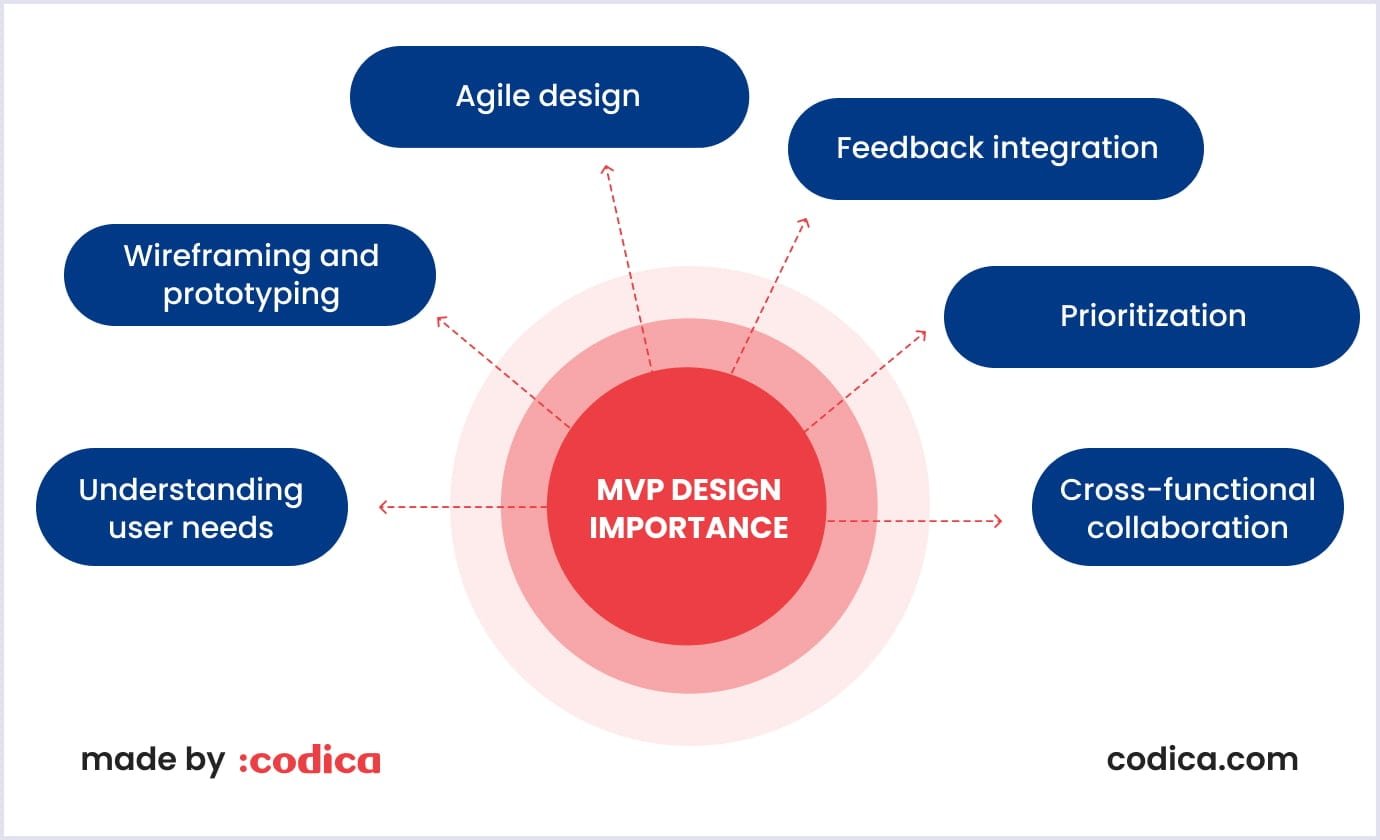
- Understanding user needs. Designers play a vital role in understanding user needs and preferences. They conduct user research and create user personas to guide the design process based on actual user behaviors and requirements.
- Wireframing and prototyping. Designers create wireframes and prototypes to visualize the product’s structure and functionality. This helps in early testing and validation of concepts before development begins.
- Agile design. In this approach, designers work iteratively, aligning with agile development methodologies. They create designs in small increments, allowing for continuous feedback and refinement throughout the development process.
- Feedback integration. Designers collaborate closely with stakeholders, developers, and users to incorporate feedback into the design. This iterative process ensures that the product evolves based on real-world insights.
- Prioritization. Designers work with product managers and stakeholders to prioritize features and functionalities based on their impact on the core value proposition. This helps in keeping the MVP application design focused on essential elements and avoiding unnecessary complexity.
- Cross-functional collaboration. Designers work closely with developers to ensure that the design is technically feasible and can be implemented within the constraints of time and resources.
What does MVP design include
A successful MVP is characterized by the strategic arrangement of elements to ensure a seamless and user-friendly journey. A positive user experience not only enhances app engagement but also leads to improved traffic and conversion rates. Hence, let’s review the key components that constitute a well-designed MVP.
User experience (UX) design
In MVP UX design, creating an optimal user experience is paramount for product success. To achieve this, it is essential to develop a UX wireframe that delineates the user’s journey through the solution.
The foundation of MVP UX design involves a meticulous analysis of the product background. This research encompasses the following:
- client interviews to ascertain project objectives and scope;
- studying market peculiarities;
- user research;
- analyzing buying and usage paths.
Comprehensive research serves as crucial support for creating wireframes and prototypes in lean UX design, providing insights into the ideal organization of MVP software components.
User interface (UI) design
The MVP software design serves as the initial impression for users interacting with the solution. A visually appealing and coherent interface plays a pivotal role in establishing brand trust. Therefore, crafting an attractive MVP application design is pivotal to capturing and retaining user interest.
Although MVP doesn’t emphasize UI design in particular (colors, fonts, imagery, logos, etc.), still a well-conceived interface involves careful attention to various interface elements, including:
- buttons;
- text fields;
- menus;
- modal windows.
The arrangement of these elements is critical in enhancing the overall user experience. Selecting appropriate sizes and maintaining a cohesive style for visual elements, such as icons and images, contributes to a more seamless and enjoyable usage process.
Cost of MVP software design
In a minimum viable product, design is primarily a functional aspect, not aesthetical. Hence, it is crucial when it comes to creating an MVP. Apart from choosing fonts, adding imagery and mixing colors, designers put a lot of work into the product. Thus, the prices for it may vary.
Here is an example from our design team. For this table, we considered a design service for marketplace MVP so that you can clearly see how important the design of each particular aspect of the product is.
| Epic | Hours | Cost, $ |
| Design system | 16 | $800 |
| Manage listing & public page | 40 | $2,000 |
| Cart & checkout | 16 | $800 |
| Search & storefront | 32 | $1,600 |
| Homepage | 16 | $800 |
| Authentication & account | 32 | $1,600 |
| Orders | 16 | $800 |
| Chat | 16 | $800 |
| Dashboard | 8 | $400 |
| Email template, favs, cookies | 8 | $400 |
| Total | 200 | $10,000 |
Codica’s expertise in creating MVP design
Throughout the years, we developed dozens of products varying in complexity, style and specialization. When it comes to developing an MVP, we have all the little details in this process. Thus, it helps us deliver exceptional quality software solutions.
One such example is Impact, a fitness app created to assist people during training while also facilitating trainers’ work. Throughout our cooperation, we delivered a whole range of services, including product discovery, UI/UX design, progressive web app (PWA), and MVP development.
Moving back to the topic, the prototypes and MVP we delivered played a crucial role in finding a balance between our and the client’s vision. For instance, here’s how the Impact prototype looked like:
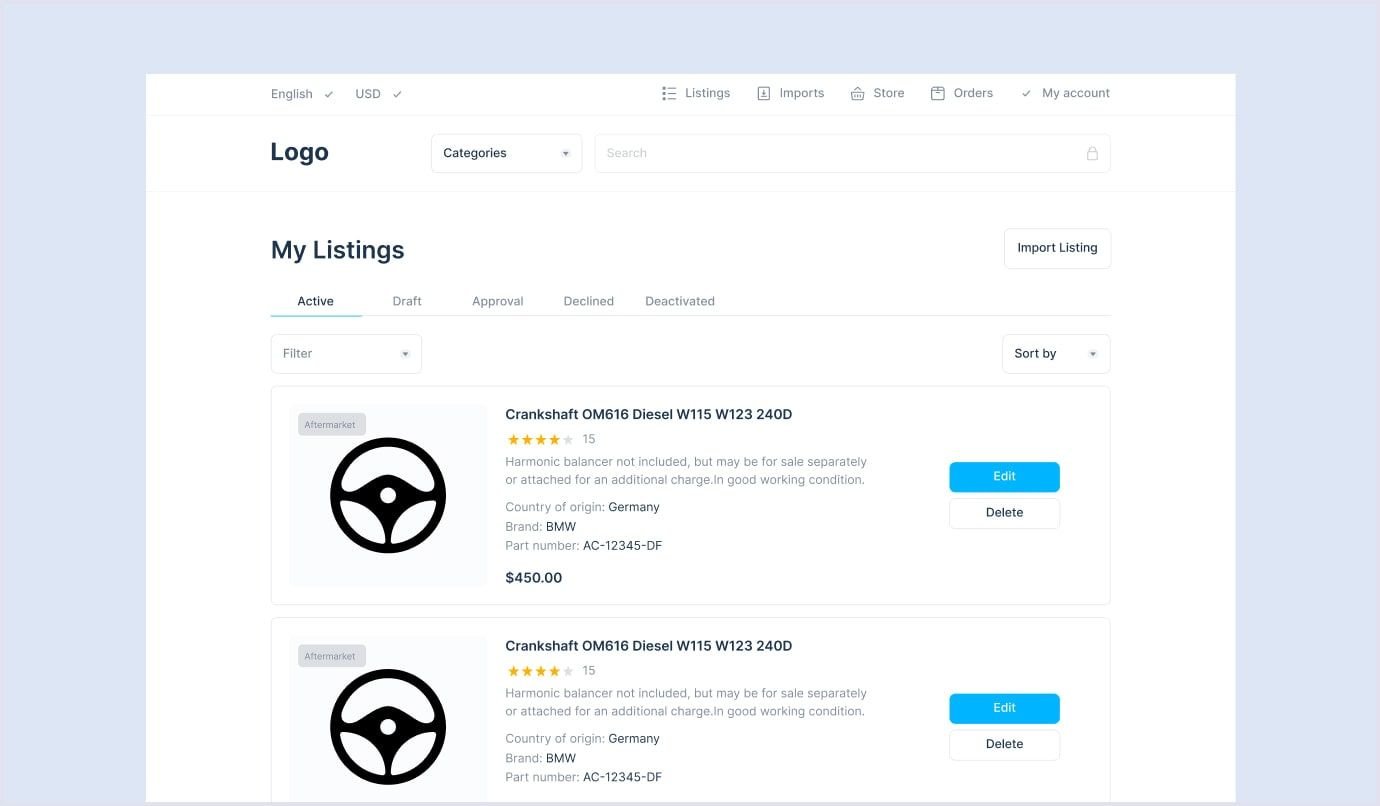
Based on this example, the MVP we delivered answered many questions and helped us decide what functionality we were aiming to see in the final product.
Consequently, we delivered a cross-platform PWA that works seamlessly on any platform, from mobile to desktop. Impact includes a database with hundreds of fitness exercises, training management functionality, nutrition programs, and metric-based performance indicators.
In the aftermath, it would be much more challenging to develop such a product without the help of prototyping and MVP. These two did their job perfectly, providing us with user feedback and quick ideas testing.
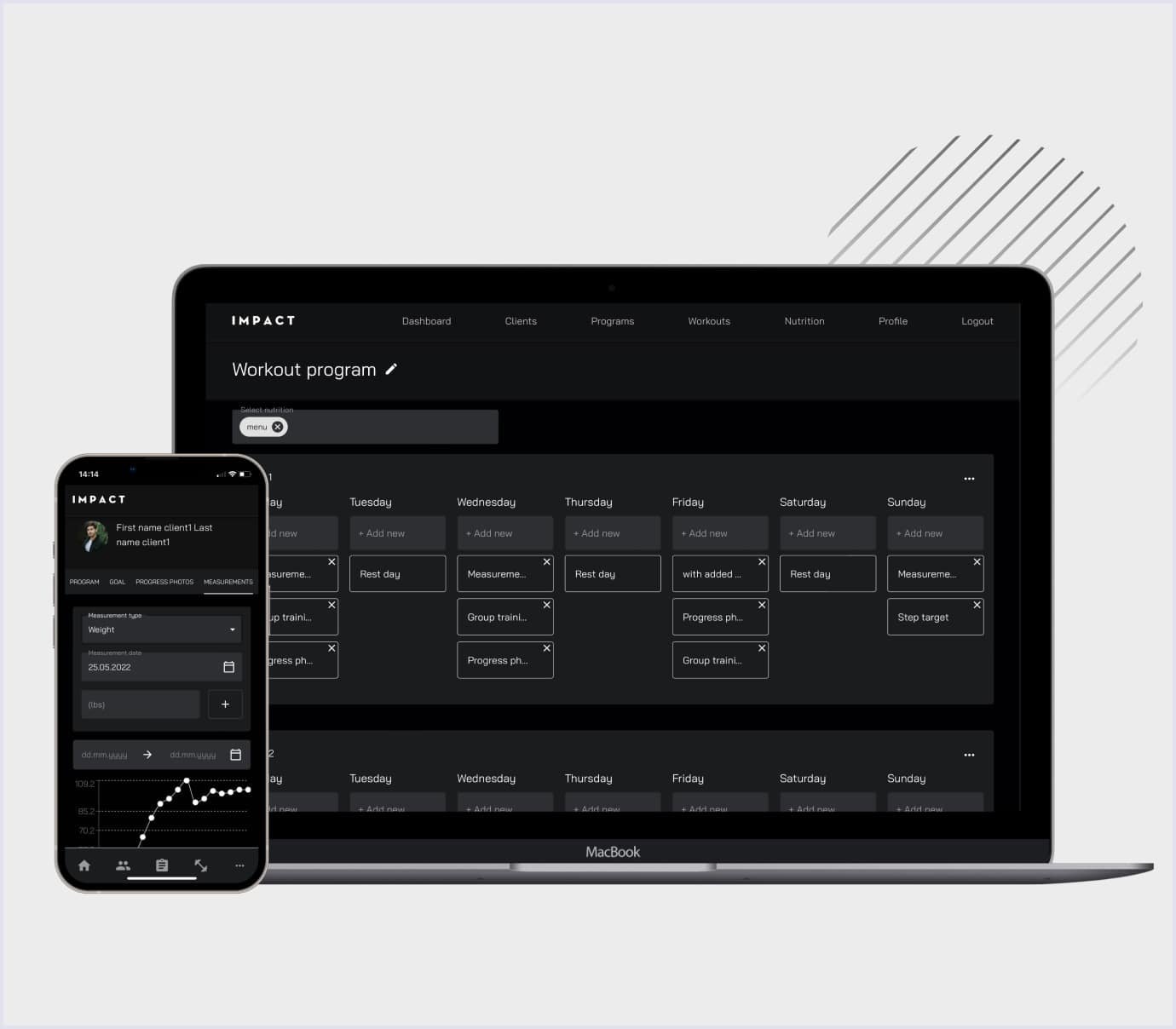
When it comes to designing an MVP, little to no aspects fall behind our expertise. However, MVP design includes many moving parts to ensure that the final product looks perfect. Hence, in another article of ours, we dive deeper into MVP design principles, outlining everything you should know before starting the project.
How to test an MVP: best ways to validate your idea
In custom software development, MVP testing is one of the most crucial aspects of the entire development process. Typically, quality assurance specialists employ various testing techniques to ensure that you create an MVP stable, performant, and working as intended.
Why is it important to test an idea?
Before diving into the best MVP testing strategies, it’s crucial to understand why testing an idea is essential. Testing allows you to gather valuable insights, validate assumptions, and ensure that your product addresses real user needs. It helps minimize risks, optimize features, and refine your strategy based on actual market feedback.
Customer interviews
Engaging in customer interviews is a fundamental step in your MVP validation. Directly interacting with potential users allows you to uncover their pain points, preferences, and expectations. By gaining qualitative insights, you can validate or adjust your initial assumptions and ensure that your MVP aligns with the actual needs of your target audience.
The good news is there are numerous ways to do so. One of the most popular is in-app surveys. They randomly appear during usage sessions and feel absolutely natural, as users can either finish them in seconds or skip them. Still, they are a good source of insights.
Crowdfunding
Such platforms provide an excellent avenue to test the market’s interest in your idea. Launching a campaign allows you to gauge the level of financial support and interest from potential customers. The success of a crowdfunding campaign can serve as an indicator of the demand for your product, helping you make informed decisions about further development and marketing strategies.
Speaking of examples, there are, again, tons of them. Perhaps some of the most popular ones are Product Hunt, StartEngine or GoFundMe. Both offer you a place to showcase your project, attract early users, and potentially find investors.
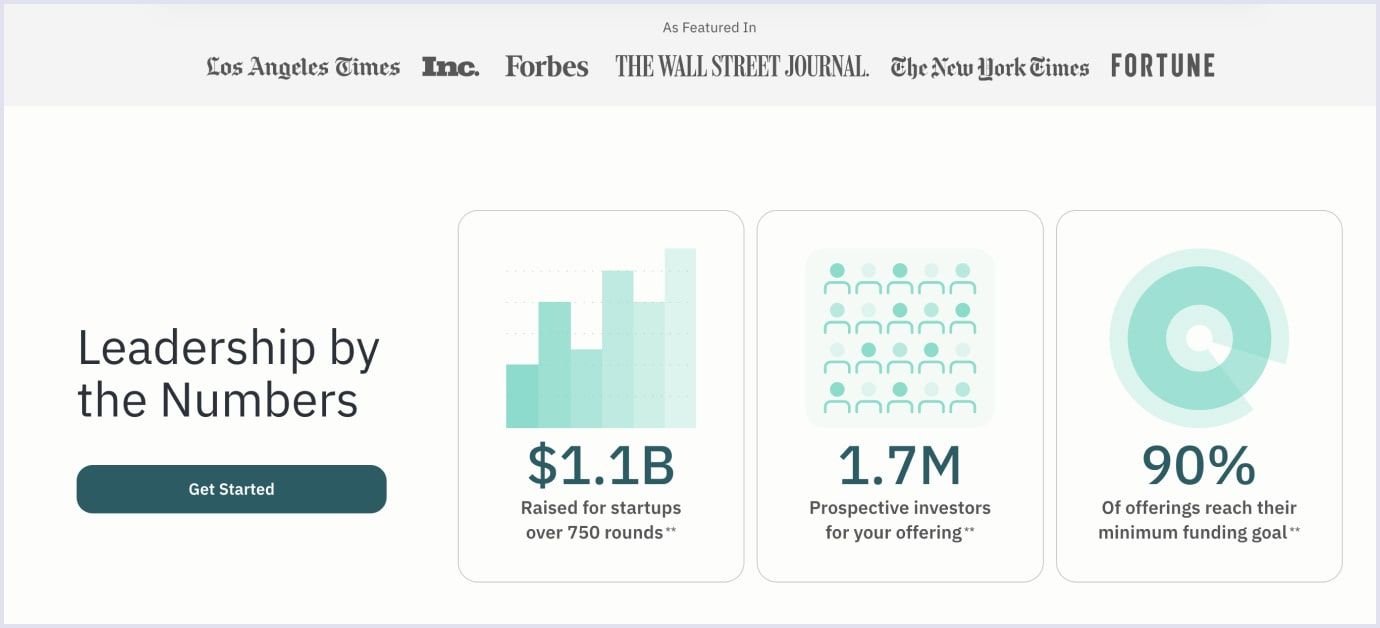
Source: StartEngine
Pre-orders
Offering pre-orders for your product MVP is an effective way to assess demand and secure initial customers. If people are willing to pay for your product before it’s fully developed, it indicates a strong interest in what you’re offering. This not only provides early validation but also generates revenue that can be used to fund the development and launch of the product.
A dedicated landing page would be of great help. In this regard, you can invest in a landing page that will present your product, communicate all important details, and redirect visitors to where they can pre-order your product.

Source: THQ Nordic
A/B tests
Among all MVP testing tools, implementing A/B tests is one of the most popular ways. It involves presenting variations of your MVP to different user groups to determine which performs better. Simply put, you roll out 2 (A and B) versions and measure which one performs better.
Now, the best part is that you can test any feature, design solution, or marketing focus with this method. A/B testing provides quantitative data that can guide decisions on refining your MVP for optimal performance.
In A/B testing, metrics are the most important part of the entire process. There are several of them, each serving a different purpose. For instance, you can measure click-through rate (CTR), bounce, retention, and conversion rates, as well as many others.
Additionally, there are dozens of platforms that greatly simplify the task. Among numerous MVP tools, there’s Hotjar, a digital experience insights software. It provides various tools to analyze the performance of either of the versions. As such, you can use heatmaps, user session recordings, or create surveys. These and several other instruments are great in providing more insights about either of the versions.
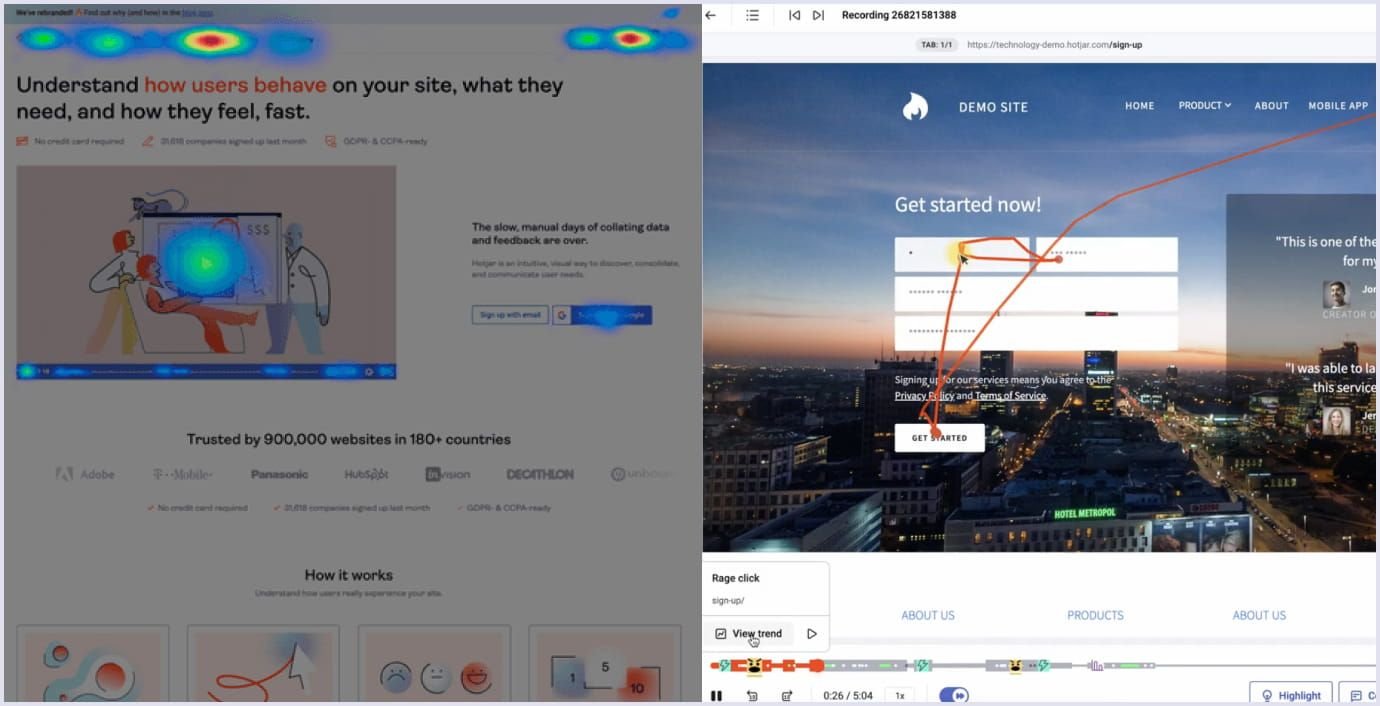
Source: Hotjar
In the aftermath, it is worth noting that MVP testing is not limited by A/B tests, interviews, and surveys. There are, in fact, myriad ways to test a minimum viable product, whereas the ones we listed are only several popular. Thus, feel free to deep dive into a topic, to unveil more about this process.
Examples of MVP
There’s clearly a reason for us to claim that absolutely all startups need an MVP. Fortunately, there are more than enough examples of MVP products supporting this approach. So, let’s take a look at the most popular minimum viable product examples.
This famous photo-sharing app started as a simple idea. Originally called Burbn, it was more about location check-ins than sharing pictures. Despite having many features, people loved one thing—sharing photos. Other apps focus on editing pictures, but none let you share them. Facebook was the big player in social media, but it didn’t offer many photo editing options.
The founders of Instagram saw a chance. They simplified Burbn, keeping only the essential—photo sharing. They made it easy to share, like, and comment on pictures. Adding filters and renaming it Instagram, they took advantage of the opportunity, launching one of the best social media networks today.
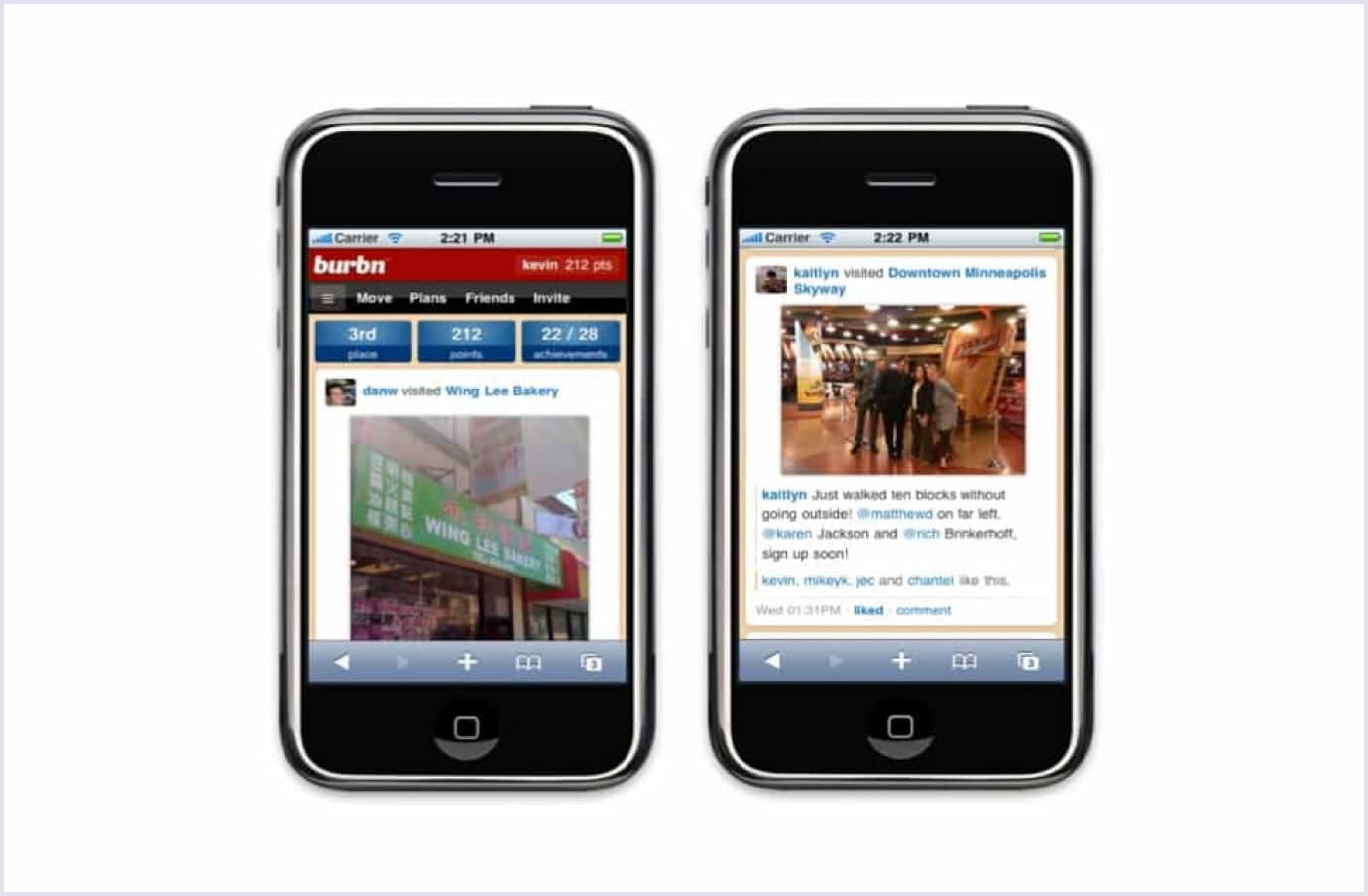
Introduced to the market as Tote, Pinterest’s initial product was a straightforward app crafted to assist women in visually cataloging their interests. This minimalist MVP centered around the pivotal "pin button," a feature that remains integral to Pinterest’s identity today.
By anchoring their minimum viable product on the pin button, Pinterest, then known as Tote, sought to gauge the market’s response to this innovative virtual interaction. Given that no other apps at the time incorporated such a feature, it was crucial for Pinterest to assess its viability before expanding into a more elaborate feature set.
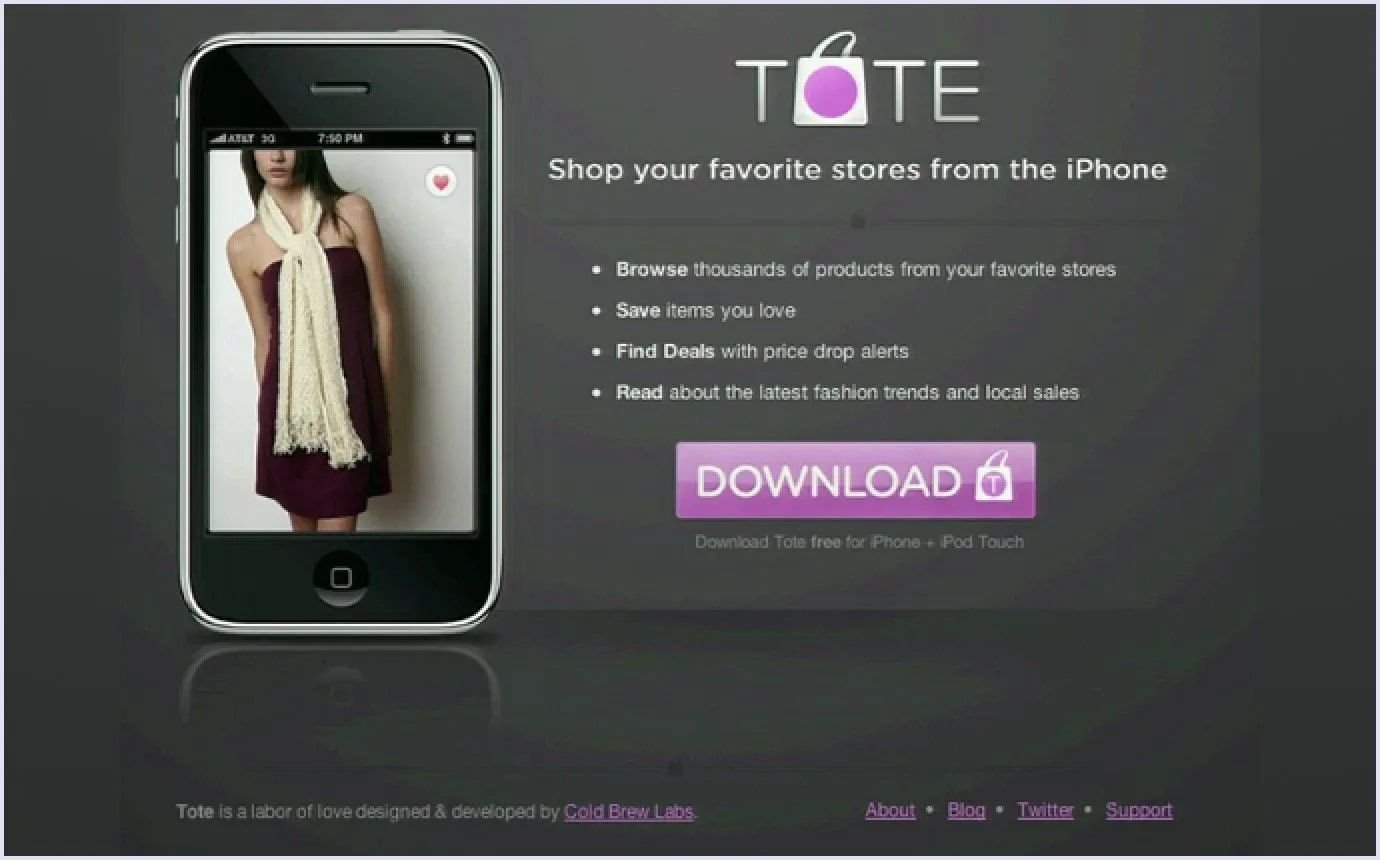
This strategic approach not only allowed them to confirm user acceptance of the pin button functionality but also positioned them in the market as a digital bookmarking site. The success of their MVP became evident as it not only validated the concept but also established Pinterest as a recognized player in the digital bookmarking landscape.
Launched in 2004, Facebook’s initial foray into the social networking scene was marked by the introduction of its MVP. This foundational version aimed to test the fundamental concept of connecting individuals through a social network, with the primary goal of collecting feedback and data to enhance the product.
The MVP iteration of Facebook was characterized by its simplicity, featuring basic functionalities like profiles, messaging, and the ability to add friends. Initially exclusive to students at Harvard, the design prioritized user-friendliness and scalability.

Successfully gathering valuable insights and data from users, the MVP played a pivotal role in Facebook’s rapid iteration and product improvement. Serving as an early illustration of the potency of the MVP concept, Facebook’s approach has since been embraced by numerous companies seeking to test and validate new products and ideas.

Spotify
Back in 2008, Daniel Ek and Martin Lorentzon saw that there was no easy way for music lovers to stream songs. So, they started a company. In just four months, they had the first version of Spotify, and soon it was out as a beta. The idea was simple: people love music, artists allow streaming, and there’s room for a quick and quality music streaming product.
They began with a basic version that fit their audience—music lovers who wanted to stream songs. They focused on simplicity and provided something legal that others were offering illegally. They got influential music bloggers in Sweden to try it out, and they loved it, spreading the word.
As Spotify grew, they added features like a free version, sharing songs, making playlists, and an offline mode for paying users. They also made a mobile app for people on the go.
By balancing its product and business strategy, Spotify has become a huge player in the market, surpassing the 246 million subscriptions mark and growing its revenue to $4+ billion in Q2 2024.
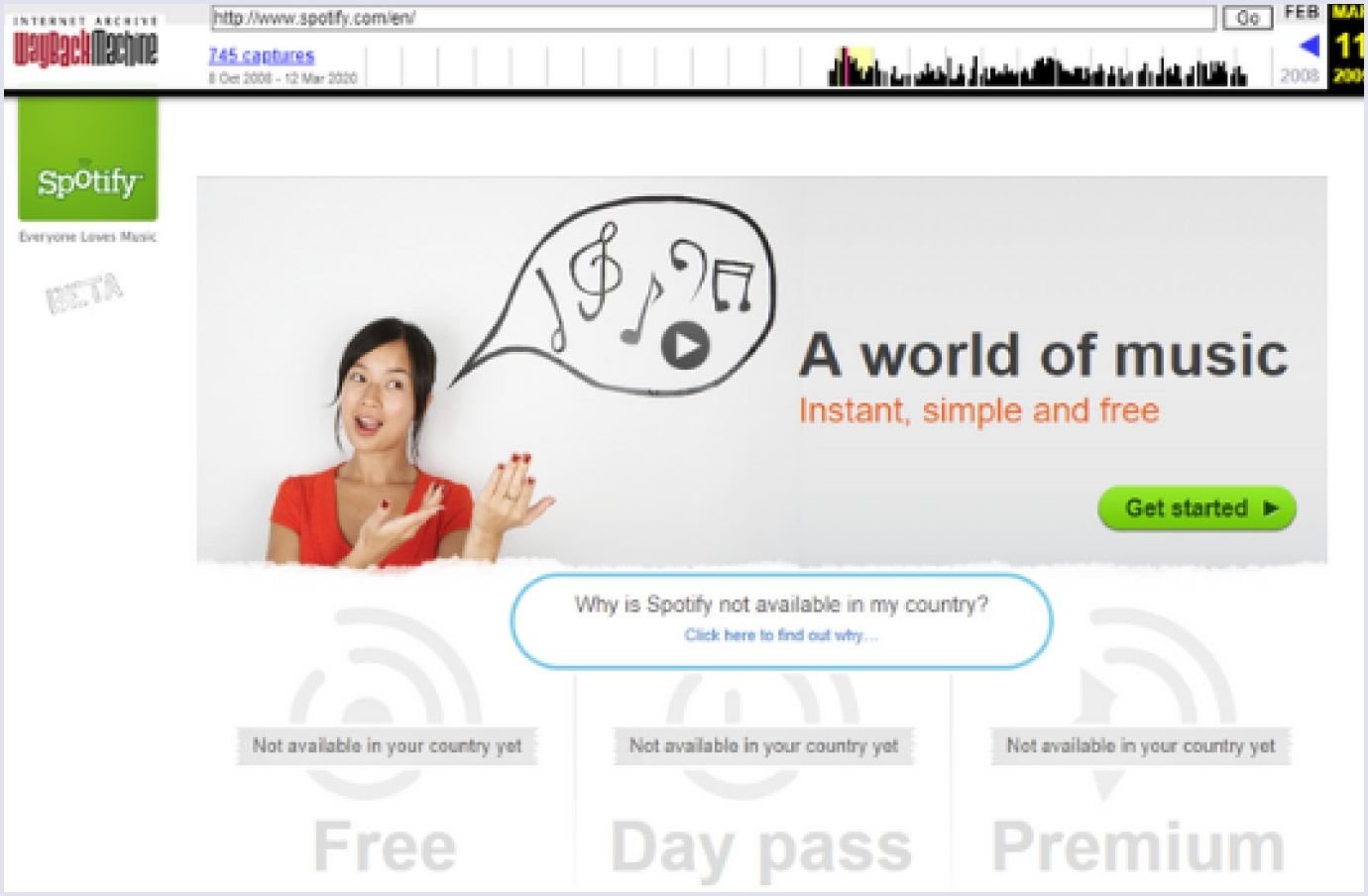
Apart from these four, there are way more MVP website examples skyrocketing startups. Hence, feel free to check an article of ours dedicated solely to MVP examples and ideas.
Tools for MVP development from scratch
Creating a minimum viable product is a complex task. Simply put, there are many moving parts requiring attention and a caring approach. Fortunately, today, you can find many tools to simplify MVP development.
Creating MVP landing page
Essentially, a landing page is a single web page created for a specific goal. In our case, it is popular in MVPs as it promotes the product, attracts early users, and previews the benefits of it. It’s designed to capture and convert visitors from marketing efforts.
So, when it comes to creating a landing page, you can give Instapage a try. This service allows you to build fast, performant, and visually appealing landing pages to attract users to your MVP.
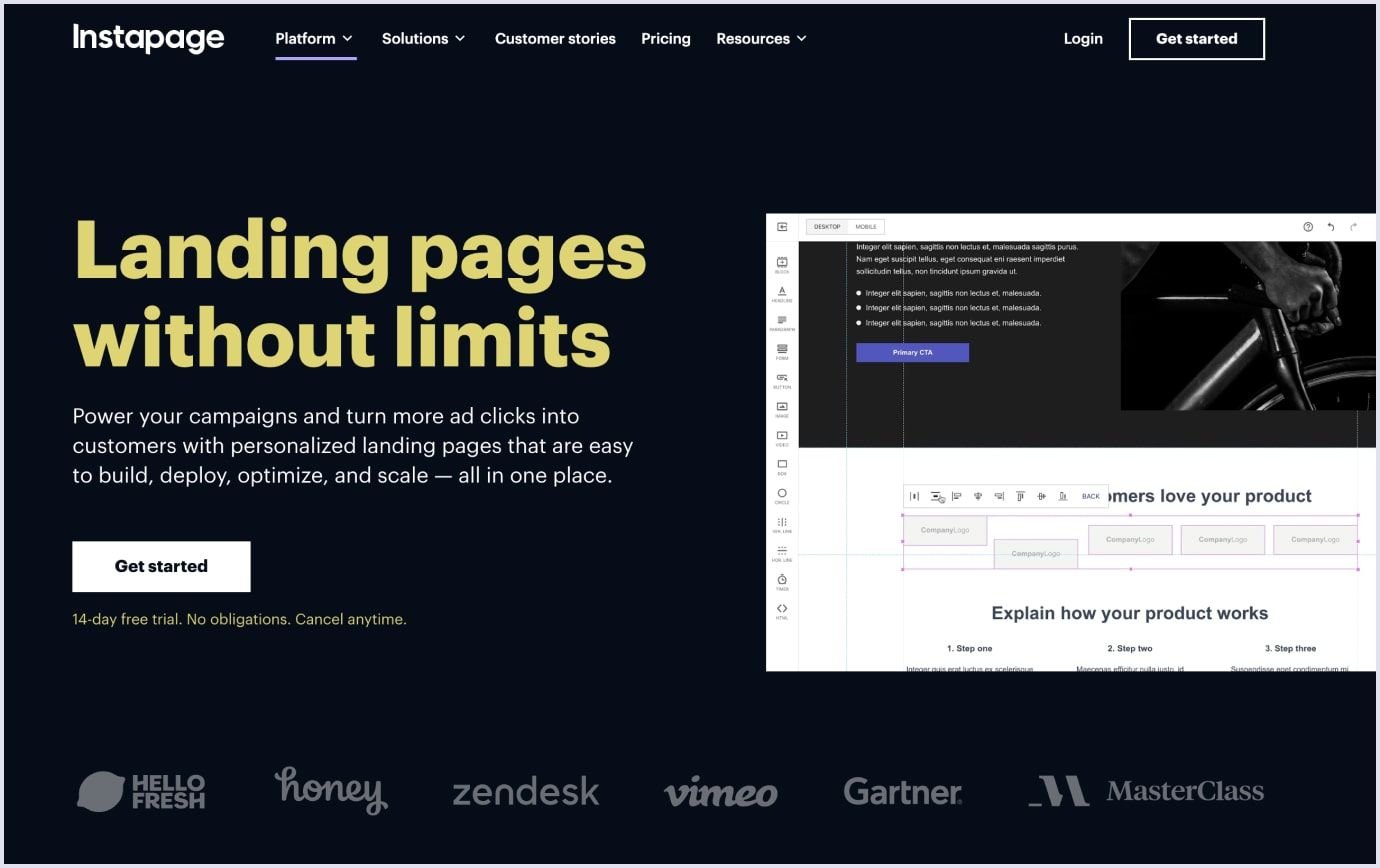
Source: Instapage
With this tool, you can implement ads, collaborate with the team, and experiment with different formats.
Handling user interviews
User feedback is your MVP’s guiding light, as they are extremely useful in directing your product’s growth. Hence, you need to collect feedback, and user interviews are doing a great job in this matter.
In this regard, you can use many MVP tools but Typeform is one of the most user-friendly and easy-to-use ones. It allows you to create personalized and striking forms to collect feedback on various aspects of your product.
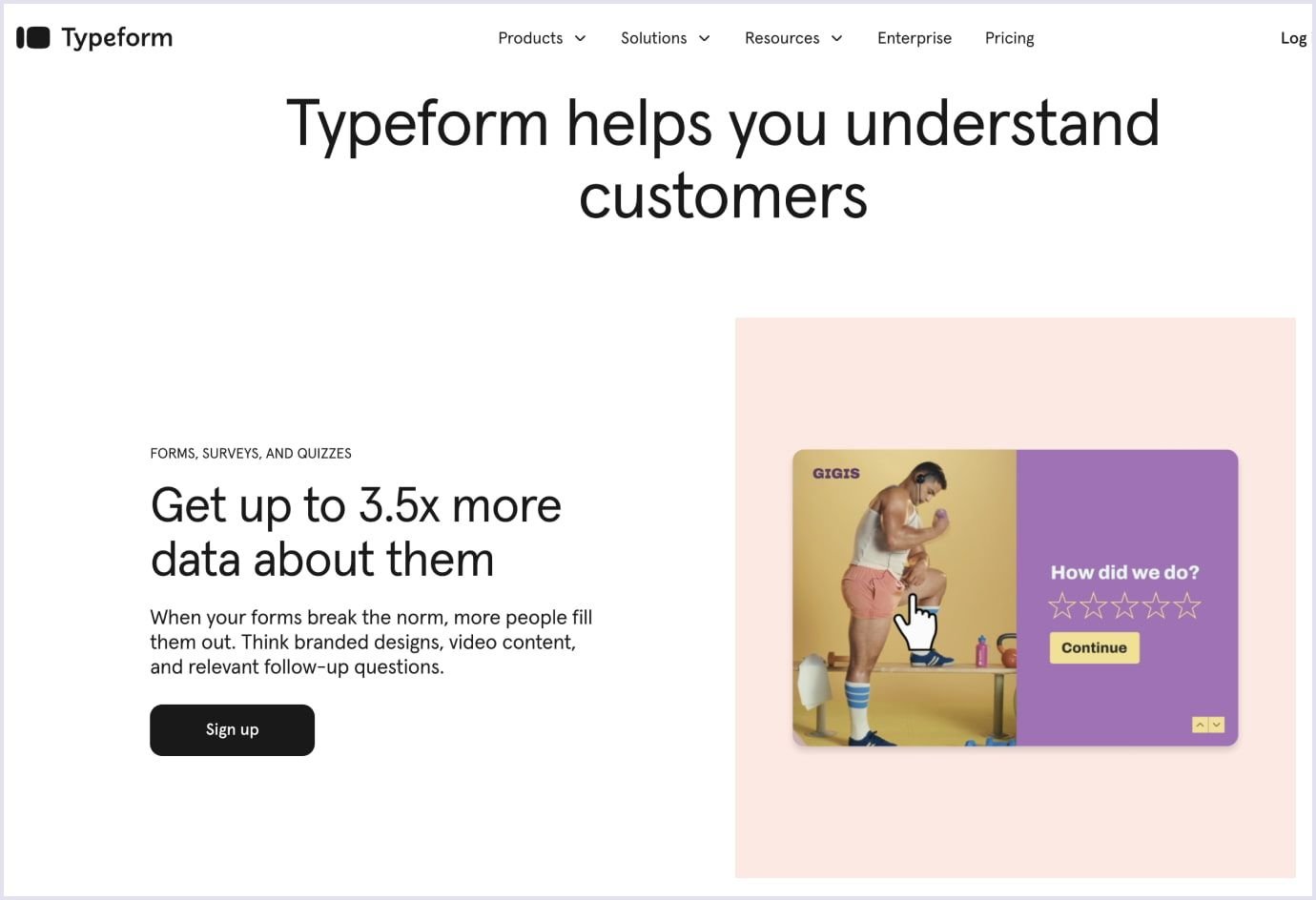
Source: Typeform
Prototyping your MVP
When it comes to creating captivating prototypes, Marvel would be a great choice. Apart from regular tools like Figma, Marvel is a dramatically easy-to-understand tool. It creates space for a close collaboration with the team, allowing you to create a whole range of things.
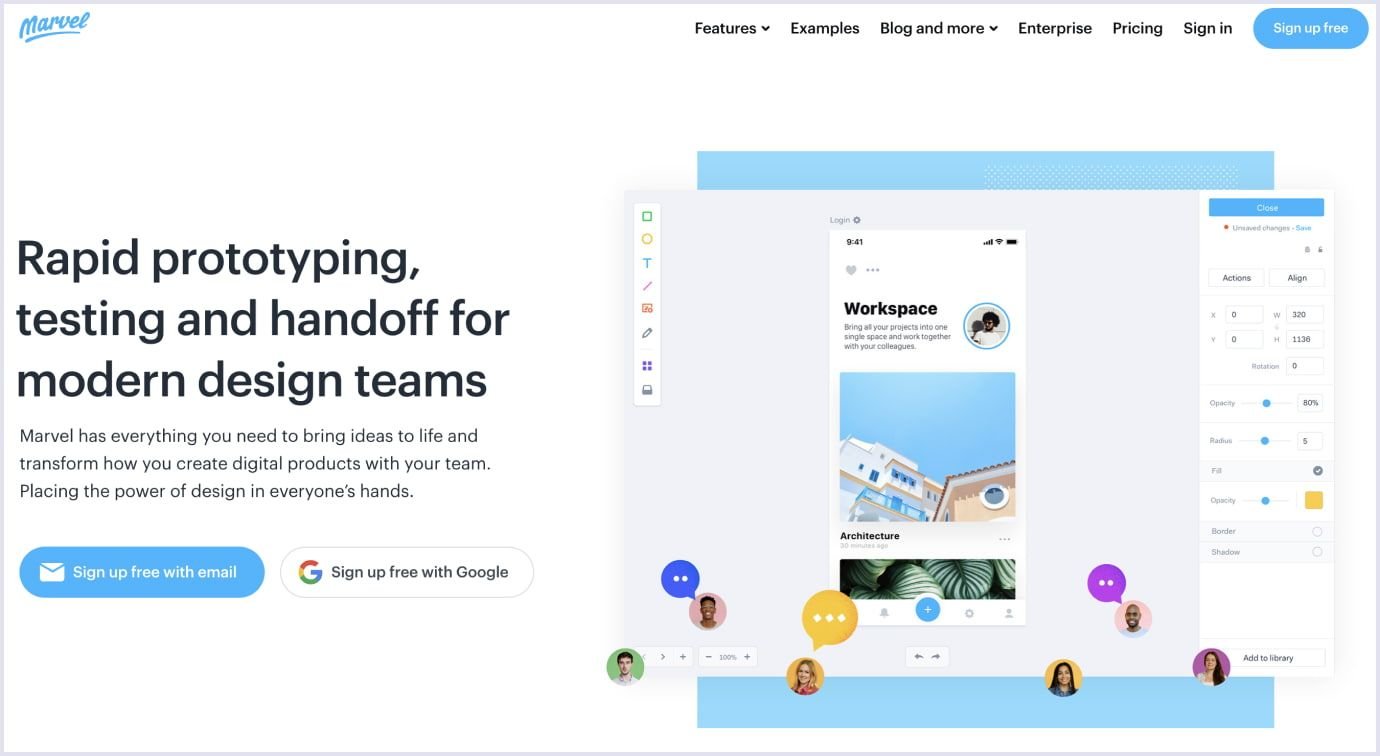
Source: Marvel
For instance, with Marvel, you can easily create simple designs, wireframes, and prototypes and even analyze their performance with user testing.
Analyzing user feedback
After creating a prototype, a landing page and even gathering feedback on them, you still need to know how to analyze it. In this regard, a tool like Hotjar can be of great assistance.
Hotjar provides functionality to analyze users’ behavior when using your product, as well as their main attention points. For instance, this tool has a heatmap feature that visualizes user behavior. Additionally, it also grants a chance to see what your users see. This way, you have a much greater chance to spot new ways to improve your product.
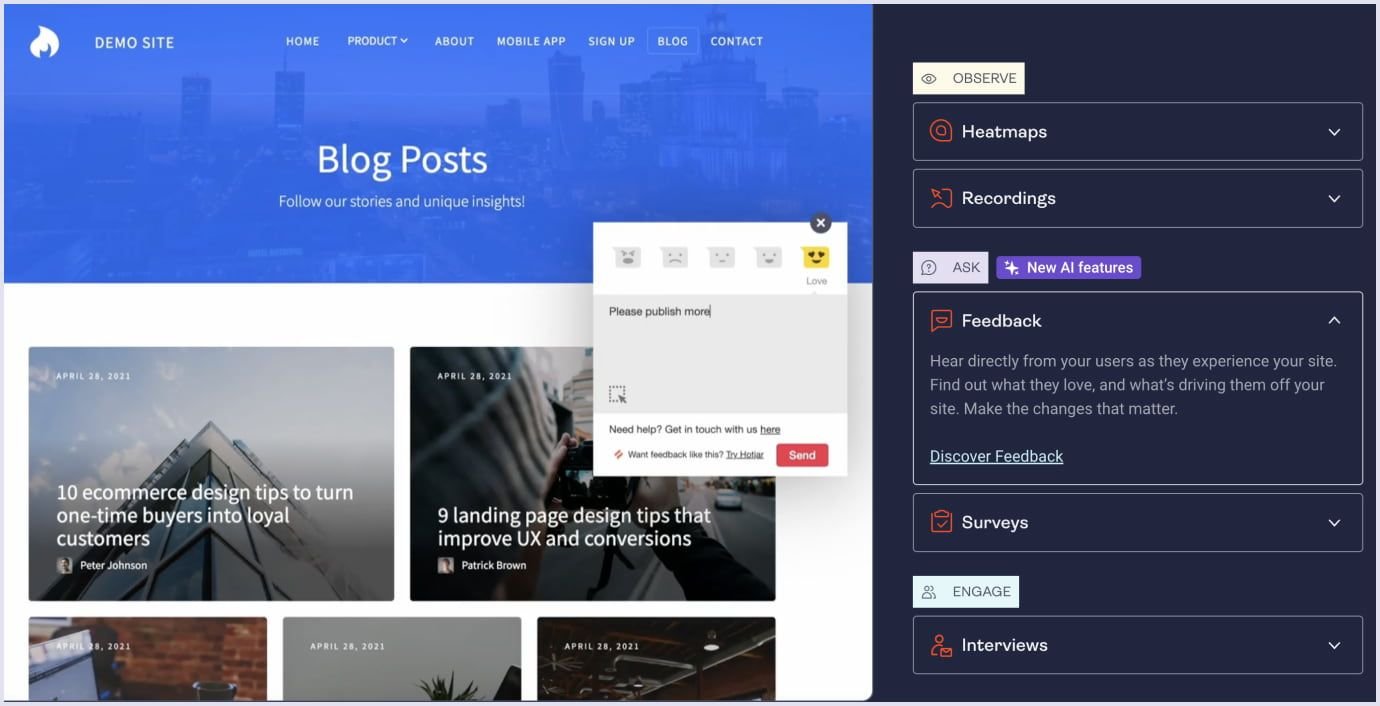
Source: Hotjar
In summary, there are dozens of tools varying in functionality and application. The ones listed above are just a sneak peek, in our list of MVP tools, we collected more than 30 tools that can help you with different aspect of MVP development.
Cost of MVP software development for startups
Money-wise, MVP price can vary a lot depending on different factors. So, let’s take a look at the most game-changing factors you ought to consider.
The complexity of the solution you’re eyeing to create
The complexity of your envisioned solution plays a pivotal role in determining the cost of MVP software development. Elaborate features, intricate functionalities, and advanced technologies contribute to increased development efforts, affecting overall expenses.
In our approach, we prefer calculating the cost of each particular feature along with the time spent on its creation. However, there are different approaches.
Project size
The scale of your MVP project significantly influences costs. Larger projects with extensive features generally require more time, resources, and effort, resulting in a higher overall cost. Evaluating the size of your project is crucial for budgeting and resource allocation.
Development partner
Choosing the right development partner has financial implications. Hourly rates vary based on the location, expertise, and reputation of the development team. Assessing the balance between cost and quality is essential in selecting a partner that aligns with your budgetary constraints and project goals.
Technology stack
The choice of technology stack directly impacts development costs. Opting for cutting-edge technologies or specialized frameworks may increase expenses while utilizing more common and readily available technologies could offer cost efficiencies. Strategic decisions regarding the technology stack are vital for managing development costs effectively.
The hourly rates of a development partner
Two pivotal elements shape the hourly rate of a development partner: location and expertise.
Speaking of the location, note that standards vary globally, impacting developers' hourly rates. For instance, in Eastern Europe, $50 per hour is considered the average rate, whereas in WEU or the U.S., the same amount of work can cost you much more, starting from $100 to $250 per hour, or even more. Hence, service costs from developers in various regions differ.
When it comes to expertise, you should also consider that developers' hourly rates correlate with their experience, falling into three categories: Junior (0 - 1 year), Middle (1 - 3+ years), and Senior (5+ years).
A middle specialist often strikes an optimal balance between quality and cost. However, companies may have unique systems for gauging developer experience.
Integrations with third-party systems
The integration of your MVP with third-party systems introduces additional cost considerations. Compatibility, customization, and the complexity of integration with external platforms contribute to the overall development costs. Careful planning and prioritization of integrations are necessary to control expenditures and streamline the development process.
Type of contract
When engaging a development partner, two prevalent contract types are the fixed price and time and material contracts.
Fixed price contract
Agreed upon initially, no provision for changes. This contract sets a specific amount for services based on precise and unchanging requirements. It ensures transparent management and a clear payment process. However, a 15%-40% margin is typically added for unforeseen risks, possibly leading to client overpayment.
Time and material contract
Flexibility and payment for actual results. This contract involves paying for work done according to the developer’s hourly rates, offering flexibility for changes in the project scope. Adjustments to requirements and features are possible, ensuring clients pay only for the actual work completed without additional costs.
Summing up all the aspects mentioned above, creating an approximate MVP costs table seems quite doable. In our example, we use $50 per hour, which is a common price for software development in Eastern Europe.
| Epic | Best case hours | Worst case hours | Cost, $ | |
| Product discovery | 80 | 160 | $4,000 | $8,000 |
| UX/UI design | 120 | 200 | $6,000 | $10,000 |
| Back-end development | 400 | 600 | $20,000 | $30,000 |
| Front-end development | 300 | 400 | $15,000 | $20,000 |
| Quality assurance/testing | 160 | 240 | $8,000 | $12,000 |
| SEO optimization | 20 | 40 | $1,000 | $2,000 |
| Code review | 40 | 60 | $2,000 | $3,000 |
| Delivery to production/DevOps | 30 | 50 | $1,500 | $2,500 |
| Project management | 120 | 240 | $6,000 | $12,000 |
| Total | 1270 | 1990 | $63,500 | $99,500 |
As you can see, MVPs are quite diverse, and the final cost may vary a lot. Hence, feel free to refer to another article by the Codica team, where we overview MVP development cost in greater detail.
Our experience in MVP development for startups
At Codica, we have a long history in MVP software development varying in complexity, niche, and functionality. By the time we are on the market, we have successfully delivered MVPs, marketplaces, mobile apps, and PWAs. So, let’s review some of our most prominent projects.
PlanMyKids
Let’s begin with one of the most interesting marketplaces we had a chance to work on. PlanMyKids is an online service marketplace aiming to aid parents in finding leisure for their children.
Among all the services we provided, MVP development services had a special place. With its help, we managed to successfully create a budget-friendly product, which is a critical achievement for a bootstrapping company. This MVP played a pivotal role in enabling the client to test their value proposition and marketing message effectively.
Speaking of functionality, PlanMyKids offers an online planner for children’s leisure activities, enabling parents to discover after-school activities tailored to their kids’ interests, family preferences, and budgets. The platform features user-friendly account management and administrative dashboards, empowering parents to plan and coordinate activities efficiently with family and friends.
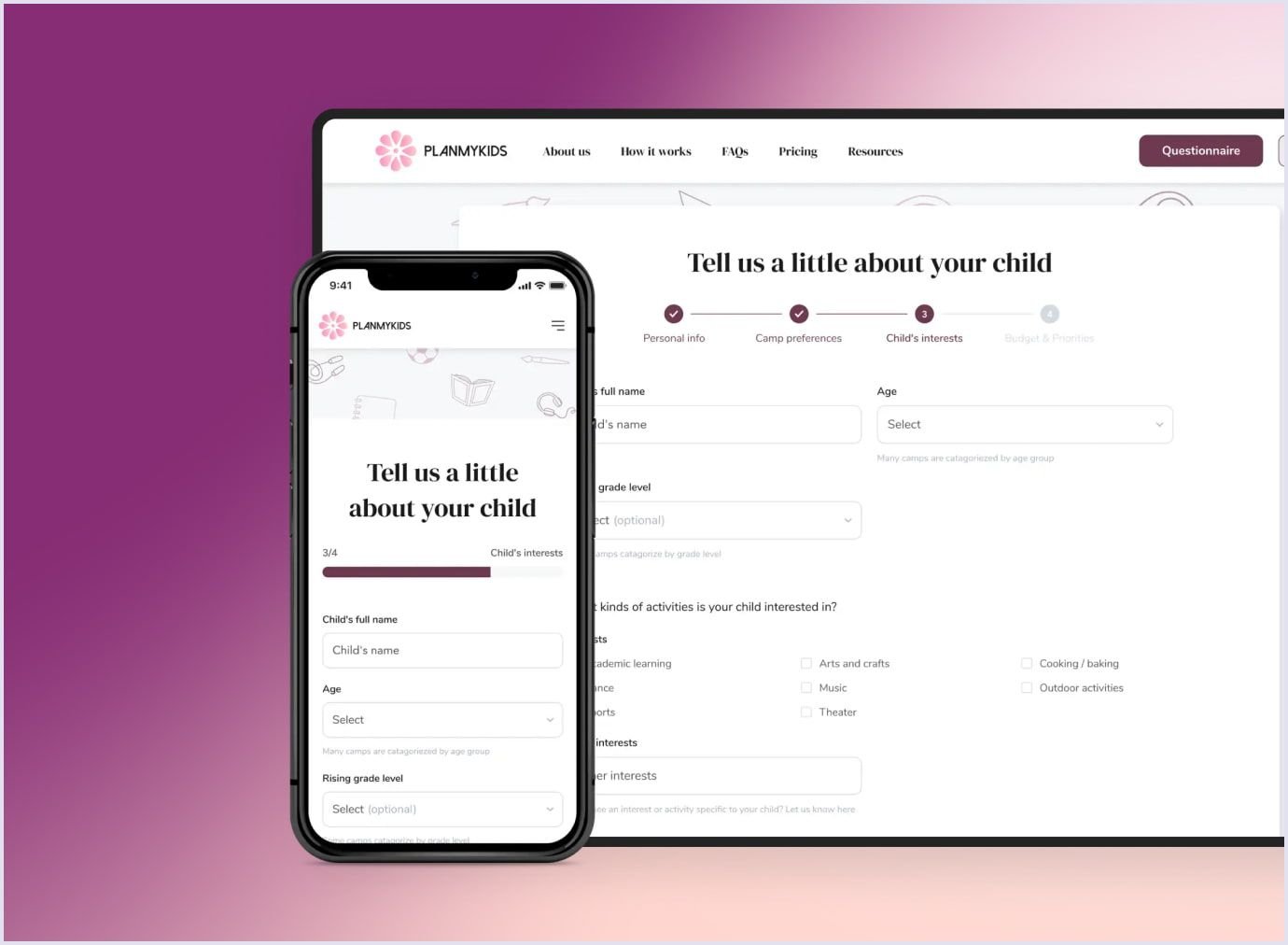
In addition to the base product, PlanMyKids has cross-platform compatibility and works as a progressive web application, offering users an enhanced mobile experience while also providing cost savings for the client in mobile app development.
Here’s what it looks like now.
Wowner
This job matching service is another successfully delivered project of ours. Wowner puts a huge emphasis on personalization, taking into account the user’s set of skills, job preferences, location, and job market opportunities.
Speaking of Codica’s role in the development, we delivered this product in the role of the progressive web app. This strategic choice enables Wowner to streamline costs and time associated with native mobile app development while ensuring an equally effective solution for both iOS and Android devices.
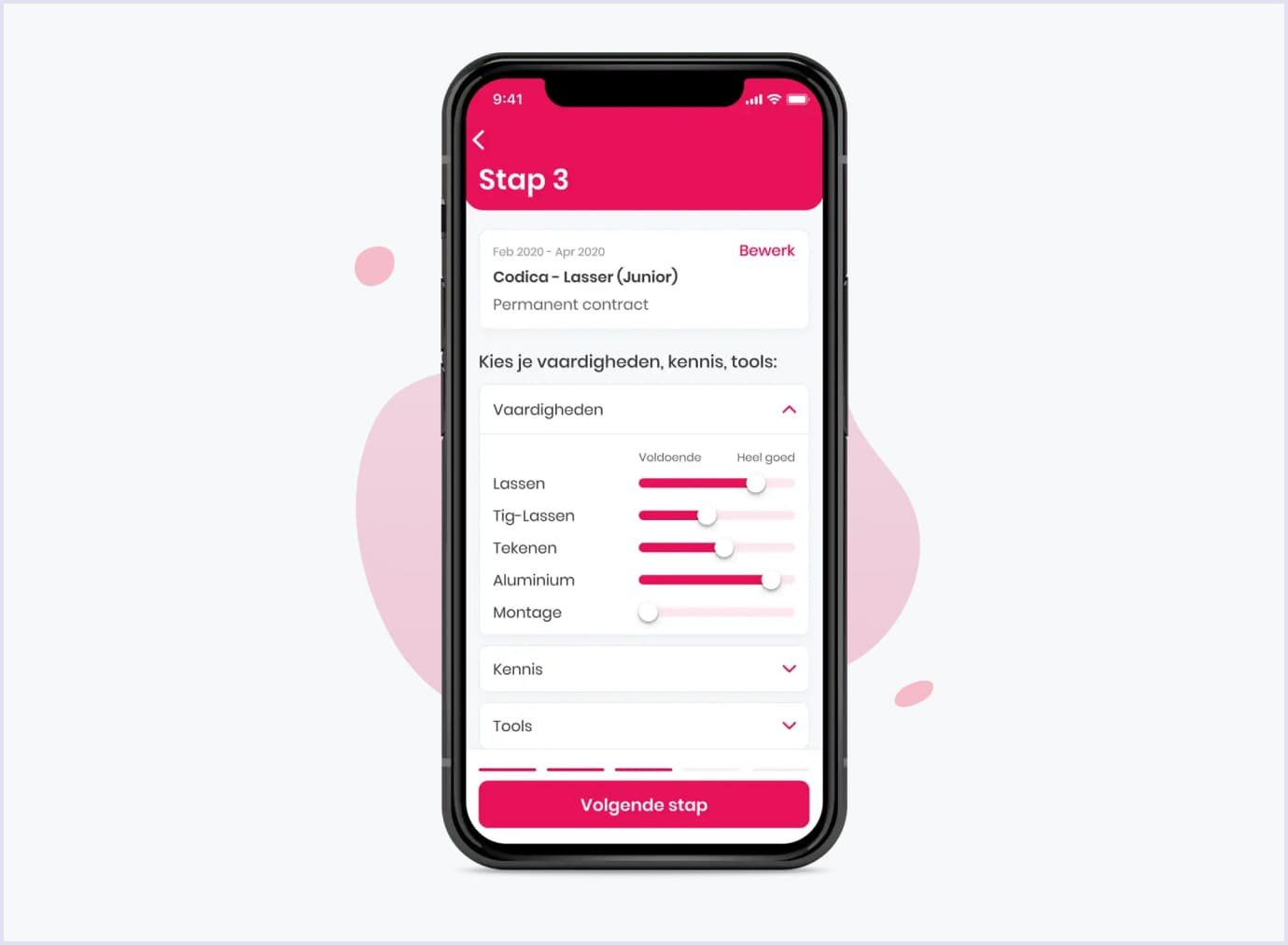
Within the platform, our team implemented a sophisticated search system facilitating the discovery of job opportunities based on users’ skill levels and preferences. This includes various factors such as rates, remote/onsite work, and additional conditions like different shifts.
In return, Wowner analyzes career opportunities in the labor market based on data users input. This functionality became possible by integrating third-party APIs into the solution. This way, it can tap into local job websites’ databases for pertinent job offers and provide recommendations and personalized offers.
In the aftermath, Wowner has a lot to offer, being a performant and user-friendly job-matching platform. Here’s a video outlining how the platform looks, works, and feels.
CakerHQ
In essence, CakerHQ is an Australian SaaS solution for bakery offering a platform for bakery businesses. It is created for business administration and works as a bridge between cake makers and customers.
Although the idea feels niched and requires an extremely careful approach, we managed to create a very performant and unique platform catering to the Australian market.
Throughout our cooperation, we designed and implemented a streamlined quotation system for submitting cake requests to bakers alongside an intuitive messaging platform. These innovations significantly enhance the communication process between cake creators and customers.
Apart from regular functionality, we added many tweaks to make CakerHQ as user-friendly as possible. For instance, our team integrated Google Places and Google Maps APIs to broaden the scope of available cake makers and provide users with information on potential delivery areas. This empowers customers to make informed decisions.
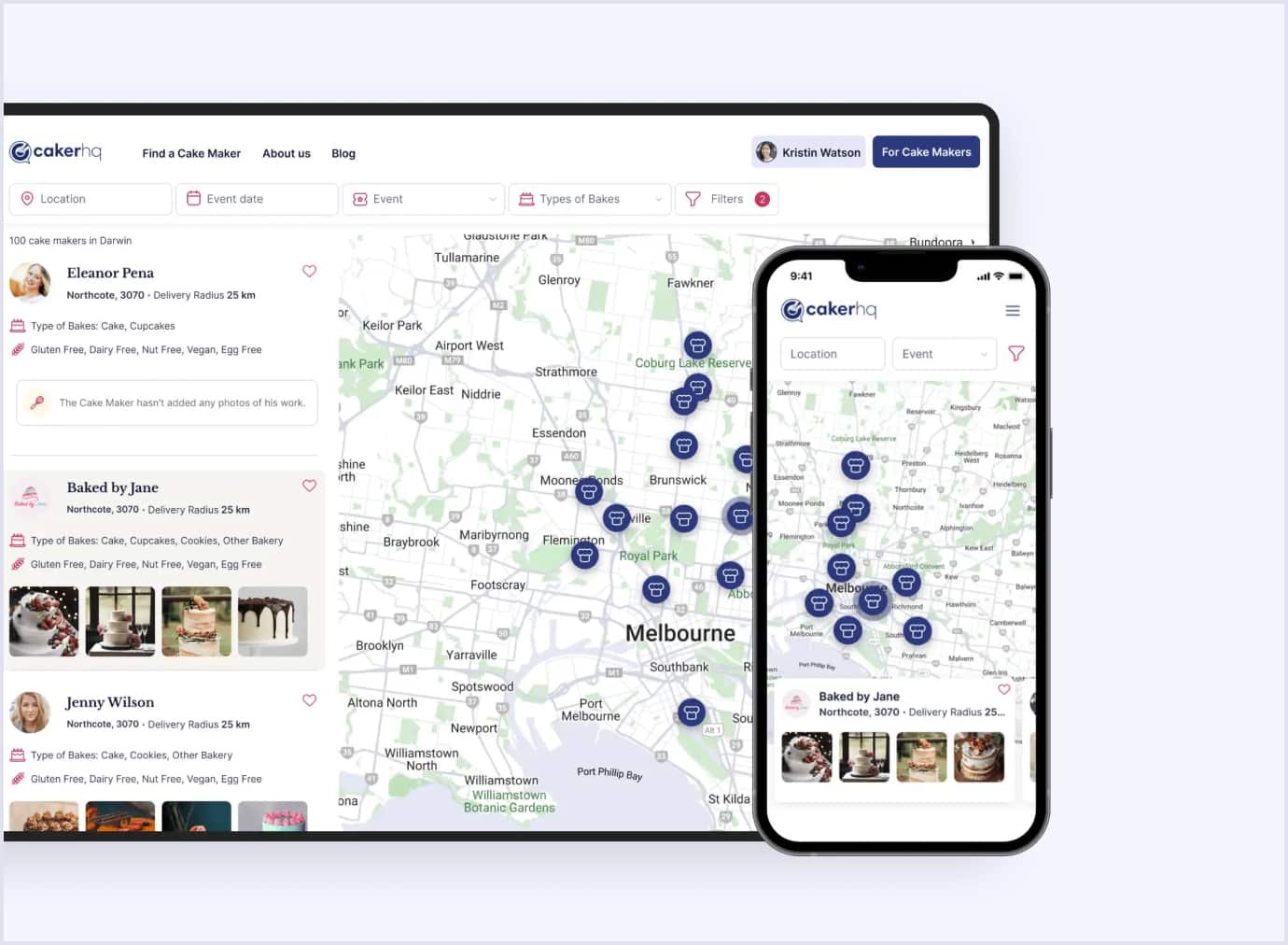
Besides, the platform also has user-friendly search filters for quick and precise results, ensuring customers can easily find exactly what they’re looking for.
Lastly, we took care of the most essential features we believe each software product should have. As such, our team optimized cross-platform compatibility, implemented a secure and modern payment system and crafted an aesthetically pleasing and user-friendly design.
Here’s a video featuring a final look at the product.
Common mistakes in MVP software development
The more popular the concept is, the more variations it may have. People tend to interpret it as they see fit, and mistakes arise accordingly. Mistakes when developing an MVP are not unheard of, and there’s a myriad of common ones. So, let’s take a look at what you should avoid.
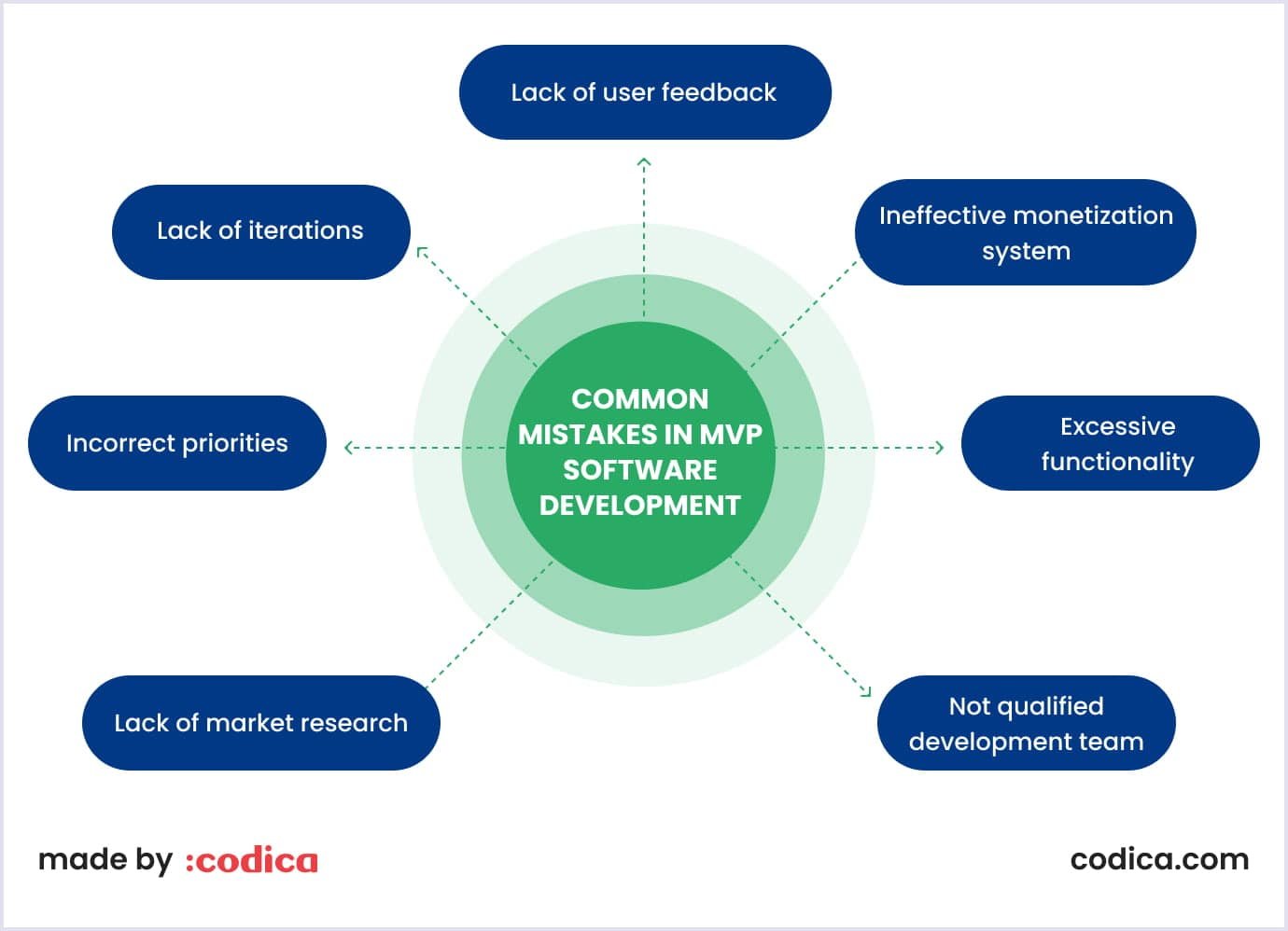
Lack of market research
MVP launch differs from the regular product launch. In fact, market research is a determining aspect when it comes to evaluating MVP’s success. Hence, launching an MVP without a thorough understanding of the target market and user needs can sabotage the entire process. Simply put, early users may not see value in your proposition, and the market itself may be too fierce during the launch.
Solution
Following the problem, the solution is quite clear and simple. Prior to publishing and even starting to develop, conduct comprehensive market research. This way, you can identify potential users, analyze competitors, and ensure that the MVP addresses a genuine market demand.
Incorrect priorities
Another common MVP mistake is focusing on features that may not be crucial to the core value proposition of the product. Poor choice of focus may lead to weak propositions and user churn.
Solution
As mentioned earlier, MVP features a limited set of functionality, sacrificing it for faster development time and cost minimization. Hence, you should always prioritize absolutely essential features only. For instance, you can evaluate the impact each feature causes and decide whether it can be omitted. Primarily, aim to solve the user’s problem and meet the primary objectives of the MVP.
Lack of iterations
Simply put, adopting a one-time development approach without incorporating feedback and making necessary adjustments can lead to both instant failure and long-term detriments. This approach fails in counting users’ feedback, making suggested edits, fixes, and more.
Solution
Adopt an iterative development process. It involves dividing the software development lifecycle (SDLC) for a sizable application into more manageable segments.
Within iterative development, everything undergoes repetitive cycles, commonly referred to as iterations or sprints. This way of working lets developers keep adding and testing new features to make the product better over time.
After all, the iterative approach provides much-needed flexibility during MVP software development. This development process creates space for continuous improvements based on user feedback and evolving requirements.
Lack of user feedback
MVP’s main purpose is in feedback gathering, and without it, all sense of the product gets lost. Neglecting to gather and analyze user feedback during and after the MVP launch can worsen the final product, making it mediocre for target users.
Solution
Realize that users’ feedback is the cornerstone of MVP. Thus, you must mobilize all resources to actively seek it. Accordingly, this can be done through surveys, analytics, and user testing. With this information, you can refine the product and address any potential concerns.
Ineffective monetization system
Literally 99% of digital products we use to generate revenue in some form. Some monetize the content, while some sell certain services. However, monetization as a field is quite complex, having different methods and tactics. Failure to adopt an effective tactic can result in a poor revenue stream and lead to even bigger issues due to the lack of funds.
Solution
The monetization model you adopt should be clearly defined. In this regard, consider user preferences and market trends, and be ready to adjust them based on user feedback. Additionally, you can diversify revenue streams, combining sales, subscription models, advertising, and partnerships. Alternatively, subscriptions and the relative tiers work perfectly fine too.
Read also: How to Build a Marketplace Website in 15 Steps: Ultimate Guide
Excessive functionality
As previously mentioned, MVP isn’t a full-scale product. It presents only essential functionality allowing people to evaluate it. Overloading the MVP with unnecessary features that do not contribute to the core value can prolong the development process and require more funding than you don’t normally expect.
Solution
With the defined problems comes the simple solution. Do not overcomplicate the MVP. Keep the product focused on essential features, avoiding unnecessary complexity and ensuring a faster time to market.
Not qualified development team
The experience of the team you entrust your platform to is crucial. Entrusting the MVP development to an inexperienced or inadequately skilled team can lead to all kinds of issues. For instance, most commonly, you can expect such teams not to respect deadlines, use irrelevant technologies, or make a myriad of organizational mistakes.
Solution
To eliminate this issue, assemble a qualified and experienced development team with expertise in the technologies relevant to the project, ensuring a higher likelihood of success. For example, employ a thorough evaluation, assessing the team's skills, experience, and track record. Additionally, establish transparent communication channels to ensure ongoing collaboration and effective problem-solving. Implement agile development methodologies for flexibility and early issue detection.
Clearly, avoiding common mistakes is challenging without a proper understanding of all the insides of the industry. Issues listed above are the tip of the iceberg, and there are much more intricate aspects you can stumble upon. Hence, feel free to study our separate deep dive on mistakes in MVP development if you’re looking to learn more.
What are the next steps after building an MVP?
The road from MVP to a full-scale product is as long as from the initial idea to the MVP. Hence, software development companies rarely yield results from MVP and create a final version of the product right away. Instead, a smoother approach takes place.
After the MVP, we can often see several other iterations, namely MMP, MLP, and MMF. Although the sequence may vary, each of them offers a unique approach and is applicable in various scenarios. So, let’s take a look.
Minimum marketable product (MMP)
After a successful MVP launch, the next crucial phase is a minimum marketable product. So what is it?
Essentially, an MMP product embodies an improved version of your MVP, integrating extra features and enhancements derived from user feedback and market demands. In straightforward terms, it is the subsequent iteration of the MVP, incorporating all the received feedback. This phase seeks to refine and optimize your product to enhance its appeal and value for a wider audience.
Minimum lovable product (MLP)
Going beyond mere market viability, let’s see what is minimum lovable product. MLP focuses on creating a product that users not only find useful but also genuinely love. This involves refining the user experience, addressing pain points, and adding features that evoke positive emotions.
By prioritizing user satisfaction and engagement, the minimum lovable product development aims to build a strong emotional connection between the product and its users.
Minimum marketable feature (MMF)
After implementing feedback with MMP and making people love your product with MLP, it is the minimum marketable feature’s turn to take action. Instead of focusing on the entire product, minimum marketable feature involves identifying and prioritizing specific features that can be released independently to generate value and market interest. This approach allows for incremental updates, keeping the product dynamic and responsive to evolving user needs.
MVP vs MLP vs MMP
Wrapping up the section, it is worth noting that each of the three serves a different purpose. It is up to you to decide which one to keep, or on which put more focus. To simplify the process, let’s outline everything there is to know about MVP, MMP, MLP, and MMF in a neat table.
| Criteria | MVP | MMP | MLP | MMF |
| Focus | Core features for basic functionality | Additional features for marketability | Enhanced user experience and emotions | Specific feature to generate market interest |
| Purpose | Validate core concept | Expand market reach and generate sales | Build emotional connection with users | Release features independently for value |
| User feedback | Collect feedback for essential features | Incorporate feedback for market acceptance | Prioritize feedback for positive user experiences | Validate market interest in specific features |
| Development stage | Early stages of product development | Evolutionary phase after MVP | Iterative development with focus on user satisfaction | Incremental releases for continuous improvement |
| User base | Limited early adopters | Broader user base | Engage a diverse audience | Generate interest from a targeted segment |
| Timeframe | Rapid development for quick validation | Gradual refinement for sustained success | Focus on iterations to make the product appealing | Timely releases for strategic impact |
| Emotional connection | Primarily functional and practical | Strategic releases to capture market interest | Focus on positive user emotions | Engage users emotionally with specific features |
| Release strategy | Release quickly to gather insights | Strategic releases to attract market attention | Iterative releases to enhance user experience | Gradual releases to create market anticipation |
| Market viability | Testing market demand and feasibility | Expanding market presence and competitiveness | Establishing strong user satisfaction | Generating interest and demand for features |
| Features | Minimum set of essential features | Comprehensive feature set for market competitiveness | Additional features for user delight | Specific features to address market demands |
| Outcome | Proof of concept with essential features | Broader market acceptance and sustained growth | User loyalty and positive sentiments | Creating buzz and demand for specific features |
Just like any topic in custom software development, this one is vast, encompassing numerous aspects. Hence, it deserves another article dedicated solely to minimum lovable product, MMP, and MMF as natural adherents to the MVP. Fortunately, we’ve got just the right piece.
Evaluating success - post MVP stage
Measuring the success of your MVP project is crucial as it gives direction for the product’s growth. In this regard, there are several aspects and metrics you should track.
Engagement
It pertains to the degree of user engagement with the product or service. You can monitor this by utilizing key metrics like platform usage duration, visit frequency, and user interactions.

Sign-up
Tracking numbers of users is vital and sign-up functionality is the best place to do so. To track this aspect, you can count the number of new user registrations and the conversion rate from visitors to registered users.
Client acquisition cost (CAC)
Being another important metric for MVP, CAC calculates the cost incurred to acquire a new client or customer for the product or service. It is calculated fairly simply: total expenses related to marketing, sales, and advertising get divided by the number of new clients acquired.
Number of paying users
It is another important number that represents how many users have subscribed or paid for premium features or services. It can help you see whether your product is valuable enough so that people make purchases instead of using a basic, free version (if any).
Churn rate
Last but not least, the churn rate represents the rate at which users discontinue or stop using the product or service. Tracking this metric allows you to spot bottlenecks and troublesome parts of your MVP creation.
How Codica can help create a successful MVP
Finding a reliable IT partner is a must if you’re planning to create a performant, well-researched, and optimized product. So, how Codica can help you create a successful MVP?
In short, with pleasure! Our team has an enormous breadth of experience creating minimum viable products for different platforms, niches and with complex functionality. As a software development company, our team lists more than 60 experts who can provide help with all the stages of MVP creation.
One advantage we believe sets us apart from the competition is the diversity we have in MVP development. Our team knows how to develop minimum viable products in many different niches, including ecommerce, automotive, travel, healthcare, and more.
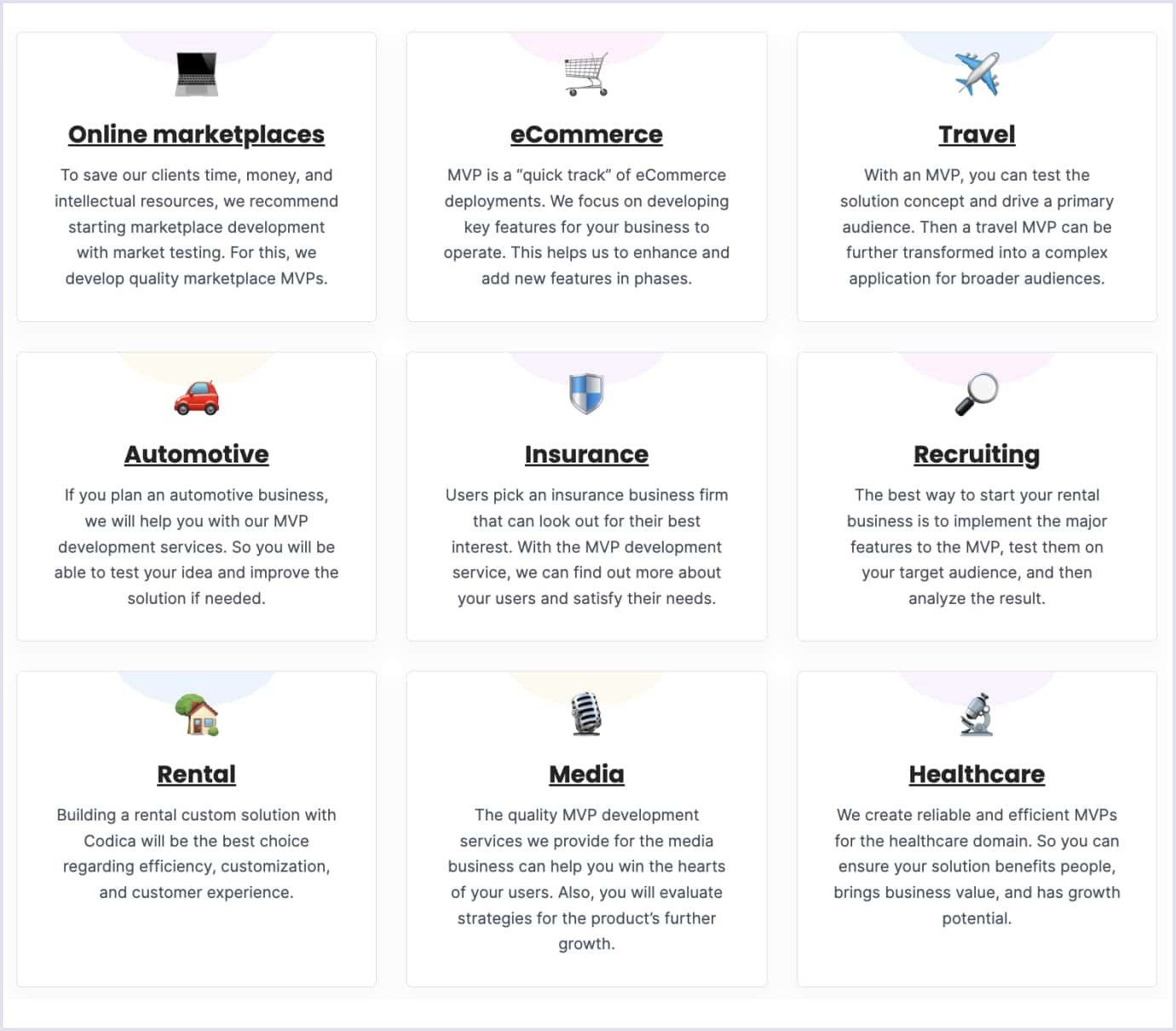
In addition to the expertise and possibility to develop across numerous industries, we aim for various-caliber businesses.
- Startups. Working with startups is evenly connected to innovations and risks. However, we would always go for it. When working with startups, we know how to minimize costs on MVP development, mobilize resources for maximum efficiency, and create outstanding software in a risk-free environment.
- Small businesses. When it comes to small businesses, MVP can play several roles. On the one hand, it can harden the idea and provide innovation in scenarios with small funding or small development teams. On the other hand, MVP can work as a magnet for new clientele, attracting people to use new features.
- Medium-sized businesses. For businesses of mid-scale proportions, our minimum viable product development services prioritize swift delivery for a cost-effective investment. Our agile approach enables careful management of the development process, mitigating risks of defects. We go the extra mile by providing both the MVP and comprehensive test coverage before the product launch, enhancing the overall user experience and safeguarding against potential resource losses.
- Enterprises. When it comes to working with enterprises, we know how high time and quality are valued. Hence, our team has the capability to transform MVPs into sophisticated and fully functional products that remain relevant in the market. Additionally, we design user-friendly interfaces and experiences to attract individuals willing to try your MVP and ensure their continued engagement.
After all, we’re glad you went on this MVP-themed journey with us. As you can see, a minimum viable product encompasses a tremendous amount of aspects. Furthermore, each of them requires understanding which we aimed to provide mixing theory with examples and case studies.
As always, feel free to refer to other articles in our blog, where we uncover everything there is to know about custom software development. Additionally, if this article sparked an enthusiastic glimpse to create an MVP for your product, make sure to contact us so we can discuss all the specifics of your future product.

